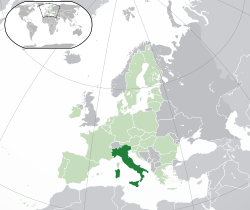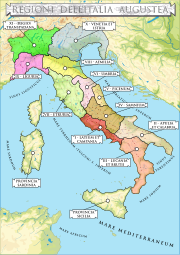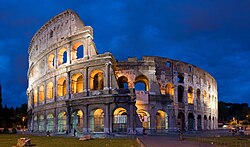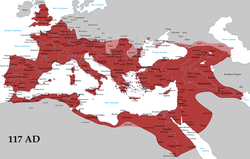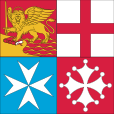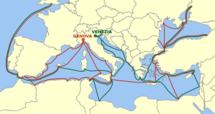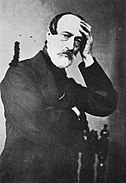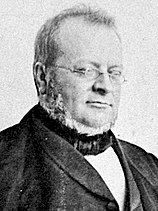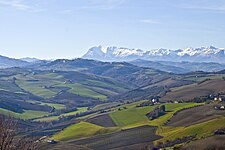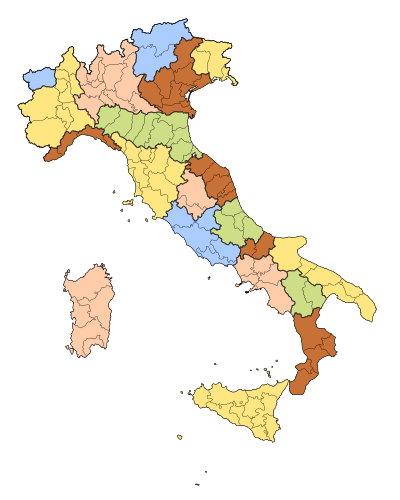Italy
 From Wikipedia the free encyclopedia
From Wikipedia the free encyclopedia
This article may be too long to read and navigate comfortably. When this tag was added, its readable prose size was 17,000 words. (June 2023) |
Italian Republic Repubblica Italiana (Italian) | |
|---|---|
| Anthem: "Il Canto degli Italiani" "The Song of the Italians" | |
Location of Italy (dark green) – in Europe (light green & dark grey) | |
| Capital and largest city | Rome 41°54′N 12°29′E / 41.900°N 12.483°E |
| Official languages | Italiana |
| Nationality (2021)[1] |
|
| Native languages | See main article |
| Religion (2020)[2] |
|
| Demonym(s) | Italian |
| Government | Unitary parliamentary republic |
| Sergio Mattarella | |
| Giorgia Meloni | |
| Ignazio La Russa | |
| Lorenzo Fontana | |
| Legislature | Parliament |
| Senate of the Republic | |
| Chamber of Deputies | |
| Formation | |
| 17 March 1861 | |
• Republic | 12 June 1946 |
| 1 January 1948 | |
| 1 January 1958 | |
| Area | |
• Total | 301,340[3][4] km2 (116,350 sq mi) (71st) |
• Water (%) | 1.24 (2015)[5] |
| Population | |
• 2022 estimate | |
• Density | 201.3/km2 (521.4/sq mi) (71st) |
| GDP (PPP) | 2024 estimate |
• Total | |
• Per capita | |
| GDP (nominal) | 2024 estimate |
• Total | |
• Per capita | |
| Gini (2020) | medium |
| HDI (2022) | very high (30th) |
| Currency | Euro (€)b (EUR) |
| Time zone | UTC+1 (CET) |
• Summer (DST) | UTC+2 (CEST) |
| Date format | |
| Driving side | right |
| Calling code | +39c |
| ISO 3166 code | IT |
| Internet TLD | .itd |
| |
Italy,[a] officially the Italian Republic,[b] is a country in Southern[13] and Western[14][c] Europe. It is located on a peninsula that extends into the middle of the Mediterranean Sea, with the Alps on its northern land border, as well as islands, notably Sicily and Sardinia.[16] Italy shares its borders with France, Switzerland, Austria, Slovenia and two enclaves: Vatican City and San Marino. It is the tenth-largest country in the Europe, covering an area of 301,340 km2 (116,350 sq mi),[3] and third-most populous member state of the European Union, with a population of nearly 60 million.[17] Its capital and largest city is Rome; other major urban areas include Milan, Naples, Turin, Florence, and Venice.
In antiquity, the Italian peninsula was home to numerous peoples; the Latin city of Rome, founded as a Kingdom, became a Republic that conquered the Mediterranean world and ruled it for centuries as an Empire.[18] With the spread of Christianity, Rome became the seat of the Catholic Church and the Papacy. During the Early Middle Ages, Italy experienced the fall of the Western Roman Empire and inward migration from Germanic tribes. By the 11th century, Italian city-states and maritime republics expanded, bringing renewed prosperity through commerce and laying the groundwork for modern capitalism.[19][20] The Italian Renaissance flourished in Florence during the 15th and 16th centuries and spread to the rest of Europe. Italian explorers discovered new routes to the Far East and the New World, leading the European Age of Discovery. However, centuries of rivalry and infighting between city-states left the peninsula divided until the late modern period.[21] During the 17th and 18th centuries, Italian economic importance waned significantly.[22]
After centuries of political and territorial divisions, Italy was almost entirely unified in 1861, following wars of independence and the Expedition of the Thousand, establishing the Kingdom of Italy.[23] From the late 19th to the early 20th century, Italy rapidly industrialized, mainly in the north, and acquired a colonial empire,[24] while the south remained largely impoverished, fueling a large immigrant diaspora to the Americas.[25] From 1915 to 1918, Italy took part in World War I on the side of the Entente against the Central Powers. In 1922, the Italian fascist dictatorship was established. During World War II, Italy was first part of the Axis until its surrender to the Allied powers (1940–1943), then, as parts of its territory were occupied by Nazi Germany, a co-belligerent of the Allies during the Italian resistance and the liberation of Italy (1943–1945). Following the end of the war, the monarchy was replaced by a republic and the country enjoyed a strong recovery.[26]
Italy has the eighth-largest nominal GDP in the world, the second-largest manufacturing industry in Europe,[27] and a significant role in regional[28] and global[29] economic, military, cultural, and diplomatic affairs. A developed country, ranking 30th in the Human Development Index, Italy is a founding and leading member of the European Union, and in numerous international institutions, including NATO, the G7, the Mediterranean Union, and the Latin Union. As a cultural superpower, Italy has long been a renowned centre of art, music, literature, cuisine, fashion, science and technology, and the source of multiple inventions and discoveries.[30] It has the world's largest number of World Heritage Sites (59), and is the fifth-most visited country.
Name
Hypotheses for the etymology of Italia are numerous.[31] One theory suggests it originated from an Ancient Greek term for the land of the Italói, a tribe that resided in the region now known as Calabria. Originally thought to be named Vituli, some scholars suggest their totemic animal to be the calf (Lat vitulus, Umbrian vitlo, Oscan Víteliú).[32] Several ancient authors said it was named after a local ruler Italus.[33]
The ancient Greek term for Italy initially referred only to the southern portion of the Bruttium peninsula and parts of Catanzaro and Vibo Valentia. The larger concept of Oenotria and "Italy" became synonymous, and the name applied to most of Lucania as well. Before the expansion of the Roman Republic, the name was used by Greeks to indicate the land between the strait of Messina and the line connecting the gulf of Salerno and gulf of Taranto, corresponding to Calabria. The Greeks came to apply the name "Italia" to a larger region.[34] In addition to the "Greek Italy" in the south, historians have suggested the existence of an "Etruscan Italy", which consisted of areas of central Italy.[35]
The borders of Roman Italy, Italia, are better established. Cato's Origines describes Italy as the entire peninsula south of the Alps.[36] In 264 BC, Roman Italy extended from the Arno and Rubicon rivers of the centre-north to the entire south. The northern area, Cisalpine Gaul, which was considered geographically part of Italy, was occupied by Rome in the 220s BC,[37] but remained politically separated. It was legally merged into the administrative unit of Italy in 42 BC.[38] The islands of Sardinia, Corsica, Sicily, and Malta were added to Italy by Diocletian in 292 AD,[39] which made late-ancient Italy coterminous with the modern Italian geographical region.[40] All its inhabitants were considered Italic and Roman.[41]
The Latin term Italicus was used to describe "a man of Italy" as opposed to a provincial, or one from the Roman province.[42] The adjective italianus, from which the term Italian was derived, is from medieval Latin and was used alternatively with Italicus during the early modern period.[43] After the fall of the Western Roman Empire, the Ostrogothic Kingdom of Italy was created. After the Lombard invasions, Italia was retained as the name for their kingdom, and its successor kingdom within the Holy Roman Empire.[44]
History
Prehistory and antiquity

Thousands of Lower Paleolithic artefacts, dating as far back as 850,000 years, have been recovered from Monte Poggiolo.[45] Excavations throughout Italy revealed a Neanderthal presence dating back to the Middle Palaeolithic period some 200,000 years ago,[46] while modern humans appeared about 40,000 years ago at Riparo Mochi.[47]
The ancient peoples of pre-Roman Italy were Indo-European peoples, most specifically of the Italic group. The main historic peoples of possible non-Indo-European or pre-Indo-European heritage include the Etruscans of central and northern Italy, the Elymians and the Sicani of Sicily, and the prehistoric Sardinians, who gave birth to the Nuragic civilisation. Other ancient populations of possibly non-Indo-European origins, include the Rhaetian people and Cammuni; known for their rock carvings in Valcamonica, which houses the largest collection of prehistoric petroglyphs in the world.[48] A well-preserved natural mummy known as Ötzi the Iceman, dated to between 3400 and 3100 BC, was discovered in the Similaun glacier of South Tyrol in 1991.[49]
The first foreign colonizers were the Phoenicians, who initially established colonies and founded emporiums on the coasts of Sicily and Sardinia. Some became small urban canters and developed parallel to the ancient Greek colonies.[50] Between the 17th and the 11th centuries BC, Mycenaean Greeks established contacts with Italy.[51] During the 8th and 7th centuries, Greek colonies were established at Pithecusae, eventually extending along the south of the Italian Peninsula and the coast of Sicily, an area later known as Magna Graecia.[52]
Ionian settlers founded Elaia, Kyme, Rhegion, Naxos, Zankles, Hymera, and Katane. Doric colonists founded Taras, Syrakousai, Megara Hyblaia, Leontinoi, Akragas, and Ghelas; the Syracusans founded Ankón and Adria; the Megarese founded Selinunte. The Achaeans founded Sybaris, Poseidonia, Kroton, Lokroi Epizephyrioi, and Metapontum; tarantini and thuriots found Herakleia. The Greek colonization placed the Italic peoples in contact with democratic forms of government and with high artistic and cultural expressions.[53]
Ancient Rome
Ancient Rome, a settlement around a ford on the River Tiber in central Italy and founded in 753 BC, was ruled for 244 years by a monarchical system. This tradition enumerated seven kings: Romulus, Numa Pompilius, Tullus Hostilius, Ancus Marcius, Tarquinius Priscus, Servius Tullius, and Tarquinius Superbus. In 509 BC, the Romans, favouring a government of the Senate and the People (SPQR), expelled the monarchy and established an oligarchic republic.
The Italian Peninsula, named Italia, was consolidated into a unified entity during the Roman expansion, the conquest of new territories often at the expense of the other Italic tribes, Etruscans, Celts, and Greeks. A permanent association, with most of the local tribes and cities, was formed, and Rome began the conquest of Western Europe, North Africa, and the Middle East. In the wake of Julius Caesar's rise and assassination in the 1st century BC, Rome over the course of centuries grew into a massive empire stretching from Britain to the borders of Persia, engulfing the whole Mediterranean basin, in which Greek, Roman, and many other cultures merged into a powerful civilisation. The long and triumphant reign of the first emperor, Augustus, began a golden age of peace and prosperity. Roman Italy remained the metropole of the empire, homeland of the Romans and the territory of the capital.[54]
The Roman Empire was among the largest in history, and wielded great economical, cultural, political, and military power. At its greatest extent, under Trajan, it had an area of 5 million square kilometres (1.9×106 sq mi).[55] The Roman legacy has deeply influenced Western civilisation shaping most of the modern world. The widespread use of the Romance languages derived from Latin, the numerical system, the modern Western alphabet and calendar, and the emergence of Christianity as a world religion are among the many legacies of Roman dominance.[56]
Middle Ages

After the fall of the Western Roman Empire, Italy fell under the power of Odoacer's kingdom, and was seized by the Ostrogoths,[57] followed by a brief reconquest under Byzantine Emperor Justinian in the 6th century. Invasions resulted in a chaotic succession of barbarian kingdoms and the supposed "dark ages". The invasion of another Germanic tribe, the Lombards, late in the same century, reduced the Byzantine presence to the rump realm of the Exarchate of Ravenna and ended political unity of the peninsula for the next 1,300 years. The peninsula was divided into north Italy and Tuscany forming the Lombard kingdom, and central-southern Italy, including the duchies of Spoleto and Benevento, controlled by the Lombards. The remaining part of the peninsula remained under the Byzantines and was divided between the exarchate of Italy, based in Ravenna, the Duchy of Rome, the Duchy of Naples, the Duchy of Calabria, and Sicily, the latter being directly dependent on the emperor at Constantinople.[58]
The Lombard kingdom was subsequently absorbed into the Frankish Empire by Charlemagne in the late 8th century and became the Kingdom of Italy.[59] The Franks helped the formation of the Papal States in central Italy. Until the 13th century, Italian politics was dominated by relations between the Holy Roman Emperors and the Papacy, with most Italian city-states siding with the former (Ghibellines) or with the latter (Guelphs) for momentary advantage.[60]
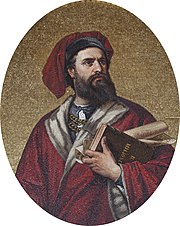
The Germanic emperor and Roman pontiff became the universal powers of medieval Europe. However, the conflict over the Investiture Controversy and the clash between Guelphs and Ghibellines led to the end of the imperial-feudal system in the north, where city-states gained independence.[61] The investiture controversy was finally resolved by the Concordat of Worms. In 1176, a league of city-states, the Lombard League, defeated the German emperor Frederick Barbarossa at the Battle of Legnano, thus ensuring effective independence for most north and central Italian cities.
City-states—such as Milan, Florence, and Venice—played a crucially innovative role in financial development by devising instruments and practices of banking and enabling new forms of social and economic organization.[62] In coastal and southern areas, the maritime republics eventually dominated the Mediterranean and monopolised trade routes to the Orient. They were independent thalassocratic city-states, though most originated from territories belonging to the Byzantine Empire. All these cities during the time of their independence had similar systems of government in which the merchant class had considerable power. Although in practice these were oligarchical, and bore little resemblance to a modern democracy, the relative political freedom they afforded was conducive to academic and artistic advancement.[63] The four best-known maritime republics were Venice, Genoa, Pisa, and Amalfi.[64] Each maritime republic had dominion over different overseas lands, including many Mediterranean islands, lands on the Adriatic, Aegean, and Black seas, and commercial colonies in the Near East and North Africa. Venice maintained enormous tracts of land in Greece, Cyprus, Istria, and Dalmatia until the mid-17th century.[65]
Right: trade routes and colonies of the Genoese (red) and Venetian (green) empires
Venice and Genoa were Europe's main gateways to trade with the East, and producers of fine glass, while Florence was a centre of silk, wool, banking, and jewellery. The wealth and business brought to Italy meant large public and private artistic projects could be commissioned. The republics were heavily involved in the Crusades, providing support and transport, but mostly taking advantage of the political and trading opportunities.[63] Italy first felt the huge economic changes in Europe which led to the commercial revolution: the Republic of Venice was able to defeat the Byzantine Empire and finance the voyages of Marco Polo to Asia; the first universities were formed in Italian cities, and scholars such as Thomas Aquinas obtained international fame; Frederick I of Sicily made Italy the political-cultural centre of a reign that temporarily included the Holy Roman Empire and the Kingdom of Jerusalem; capitalism and banking families emerged in Florence, where Dante and Giotto were active around 1300.[19]
In the south, Sicily had become an Arab Islamic emirate in the 9th century, thriving until the Italo-Normans conquered it in the late 11th century, together with most Lombard and Byzantine principalities of southern Italy.[66] Southern Italy developed as a unified kingdom, first under the House of Hohenstaufen, then the Capetian House of Anjou, and under the House of Aragon from the 15th century. In Sardinia, the former Byzantine provinces became independent states known in Italian as Judicates. The Black Death of 1348 killed perhaps one third of the population of Italy.[67]
Early modern period

Italy was the birthplace and heart of the Renaissance during the 1400s and 1500s. The Italian Renaissance marked the transition from the medieval period to the modern age as Europe recovered, economically and culturally, from the crises of the Late Middle Ages and entered the Early Modern Period. The Italian polities were now regional states effectively ruled by princes, who were de facto monarchs in control of trade and administration, and their courts became major centres of the arts and sciences. The Italian princedoms represented the first modern states, as opposed to feudal monarchies and multinational empires. The princedoms were led by political dynasties and merchant families such as the Medici in Florence; the Visconti and Sforza in the Duchy of Milan.[68][69] The Renaissance was fostered by the wealth accumulated by merchant cities combined and patronage of its dominant families.[68] The Italian Renaissance exercised a dominant influence on subsequent European painting and sculpture for centuries, with artists such as Leonardo da Vinci, Brunelleschi, Botticelli, Michelangelo, Raphael, Giotto, Donatello, and Titian, and architects such as Filippo Brunelleschi, Leon Battista Alberti, Andrea Palladio, and Donato Bramante.
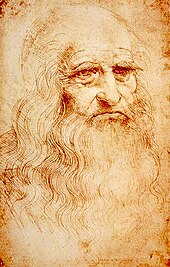
Following the conclusion of the western schism in favour of Rome at the Council of Constance (1415–1417), newly elected Pope Martin V returned to the Papal States and restored Italy as the sole centre of Western Christianity. The Medici Bank was made the official credit institution of the Papacy, and significant ties were established between the Church and new political dynasties. The Popes' status as elective monarchs turned the conclaves and consistories of the Renaissance into political battles between the courts of Italy for primacy in the peninsula and access to the immense resources of the Church. In 1439, Pope Eugenius IV and the Byzantine Emperor John VIII Palaiologos signed a reconciliation agreement between the Catholic Church and the Orthodox Church at the Council of Florence hosted by Cosimo the old de Medici. In 1453, Italian forces under Giovanni Giustiniani were sent by Pope Nicholas V to defend Constantinople it was lost to the more advanced Turkish army, and Byzantium fell to Sultan Mehmed II.
The fall of Constantinople led to the migration of Greek scholars and texts to Italy, fuelling the rediscovery of Greco-Roman Humanism.[70] Humanist rulers such as Federico da Montefeltro and Pope Pius II worked to establish ideal cities where man is the measure of all things, and therefore founded Urbino and Pienza, respectively. Pico della Mirandola wrote the Oration on the Dignity of Man, considered as the manifesto of Renaissance Humanism, in which he stressed the importance of free will. Humanist historian Leonardo Bruni was the first to divide human history into three periods: Antiquity, Middle Ages, and Modernity.[71] The second consequence of the Fall of Constantinople was the Age of Discovery.

Italian[d] explorers and navigators from the dominant maritime republics, eager to find an alternative route to the Indies to bypass the Ottoman Empire, offered their services to monarchs of Atlantic countries and played a key role in ushering the Age of Discovery and European colonization of the Americas. The most notable were: Christopher Columbus, credited with discovering the New World and the opening of the Americas for conquest and settlement by Europeans;[72] John Cabot, the first European to set foot in "New Found Land" and explore parts of North America in 1497;[73] Amerigo Vespucci, who, around 1501, first demonstrated that the New World was not Asia, but a fourth continent previously unknown to people of the Old World (America is named after him);[74] and Giovanni da Verrazzano, the first European to explore the Atlantic coast of North America between Florida and New Brunswick in 1524.[75]
The wars in Lombardy came to an end; and a defensive alliance known as Italic League was formed between Venice, Naples, Florence, Milan, and the Papacy. Lorenzo the Magnificent de Medici was the greatest Florentine patron of the Renaissance and supporter of the Italic League. His support allowed the League to maintain itself in the aftermath of the Pazzi Conspiracy and aborted the invasion of Italy by the Turks. However, the military campaign of Charles VIII of France in Italy resulted in the disbandment of the League and initiated the Italian Wars between the Valois and the Habsburgs. During the High Renaissance of the 1500s, Italy was, therefore, the main European battleground as well as its cultural-economic centre. Popes such as Julius II (1503–1513) fought for the control of Italy against foreign monarchs; others, such as Paul III (1534–1549), preferred to mediate between the European powers to secure peace in Italy. In the middle of this conflict, the Medici popes Leo X (1513–1521) and Clement VII (1523–1534) opposed the Protestant Reformation and advanced the interests of their family. In 1559, at the end of the Italian wars, many states of north Italy remained part of the Holy Roman Empire, indirectly subjected to the Austrian Habsburgs, while all of Southern Italy (Naples, Sicily, Sardinia) and Milan were under Spanish Habsburg rule.
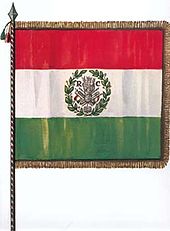
The Papacy remained a powerful force and launched the Counter-reformation. Key events include: the Council of Trent (1545–1563); excommunication of Elizabeth I (1570) and the Battle of Lepanto (1571), which occurred during the pontificate of Pius V, the adoption of the Gregorian calendar, and the Jesuit China mission of Matteo Ricci under Pope Gregory XIII; the French Wars of Religion; the Long Turkish War and the execution of Giordano Bruno in 1600, under Pope Clement VIII; the birth of the Lyncean Academy, of which the main figure was Galileo Galilei; the final phases of the Thirty Years' War (1618–1648); and the formation of the last Holy League by Innocent XI during the Great Turkish War.
The economy declined during the 1600s and 1700s. Following the European wars of succession of the 18th century, the North fell under the influence of the Habsburg-Lorraine of Austria, while the South passed to a cadet branch of the Spanish Bourbons. During the Coalition Wars, north and central Italy were reorganised by Napoleon as Sister Republics of France and, later, as a Kingdom of Italy in personal union with the French Empire.[76] The southern half of the peninsula was administered by Joachim Murat, Napoleon's brother-in-law, who was crowned as King of Naples. The 1814 Congress of Vienna restored the situation of the late 18th century, but the ideals of the French Revolution could not be eradicated, and re-surfaced during the political upheavals that characterised the first part of the 19th century.
The Italian national colours appeared initially on a tricolour cockade in 1789,[77] seven years before the adoption of the first Italian tricolour war flag by the Lombard Legion in 1796.[78] The first official adoption of the Italian tricolour as a national flag by a sovereign Italian state, the Cispadane Republic, took place in 1797, during the Napoleonic era, following the French Revolution (1789–1799), which advocated national self-determination.[79] This event is celebrated by Tricolour Day.[80]
Unification
The birth of the Kingdom of Italy was the result of efforts of Italian nationalists and monarchists loyal to the House of Savoy to establish a united kingdom encompassing the entire Italian Peninsula. By the mid-19th century, rising Italian nationalism led to revolutionary political upheaval.[83] Following the Congress of Vienna in 1815, the political and social Italian unification movement, or Risorgimento, emerged to unite Italy by consolidating the states of the peninsula and liberating them from foreign control. A radical figure was the patriotic journalist Giuseppe Mazzini, member of the secret revolutionary society, the Carbonari, and founder of the political movement Young Italy in the early 1830s, who favoured a unitary republic and advocated a broad nationalist movement. His prolific output of propaganda helped the unification movement stay active. In this context, in 1847 the first public performance of the song "Il Canto degli Italiani", which became the Italian national anthem in 1946, took place.[84]
The most famous member of Young Italy was the revolutionary and general Giuseppe Garibaldi, who was renowned for his loyal followers[85] and who led the Italian republican drive for unification in Southern Italy. However, the north Italian monarchy of the House of Savoy, in the Kingdom of Sardinia, whose government was led by Camillo Benso, Count of Cavour, also had ambitions of establishing a united Italian state. In the context of the 1848 liberal revolutions that swept through Europe, an unsuccessful first war of independence was declared against Austria. In 1855, the Kingdom of Sardinia became an ally of Britain and France in the Crimean War, making Cavour's diplomacy legitimate in the eyes of the great powers.[86] The Kingdom of Sardinia fought the Austrian Empire in the Second Italian War of Independence of 1859, with the aid of France, resulting in liberating Lombardy. On the basis of the Plombières Agreement, the Kingdom of Sardinia ceded Savoy and Nice to France, an event that caused the Niçard exodus and Niçard Vespers.[87]
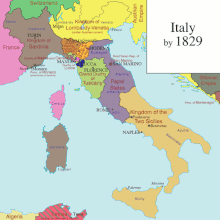
In 1860–61, Garibaldi led the drive for unification in Naples and Sicily,[88] while the House of Savoy troops occupied the central territories of the Italian peninsula, except for Rome and part of the Papal States. Teano was the site of a famous meeting between Garibaldi and Victor Emmanuel II, the last king of Sardinia, during which Garibaldi shook Victor Emanuel's hand and hailed him as King of Italy. Thus, Garibaldi sacrificed republican hopes for the sake of Italian unity. Cavour agreed to include Garibaldi's Southern Italy in a union with the Kingdom of Sardinia in 1860. This allowed the Sardinian government to declare a united Italian kingdom on 17 March 1861.[89] Victor Emmanuel II then became the first king of a united Italy, and its capital was moved from Turin to Florence.
In 1866, Victor Emmanuel II, allied with Prussia during the Austro-Prussian War, waged the Third Italian War of Independence, which resulted in Italy annexing Venetia. Finally, in 1870, as France abandoned its garrisons in Rome during the Franco-Prussian War the Italians filled the power gap by capturing the Papal States. Italian unification was completed, and the capital moved to Rome. Victor Emmanuel, Garibaldi, Cavour, and Mazzini have been referred as Italy's Four Fathers of the Fatherland.[81]
Liberal period
The Constitutional Law of Sardinia, was extended to the whole of Italy in 1861, and provided basic freedoms for the new state; but electoral laws excluded the non-propertied and uneducated classes. The new kingdom was governed by a parliamentary constitutional monarchy dominated by liberal forces. As northern Italy quickly industrialised, the southern and northern rural areas remained underdeveloped and overpopulated, forcing millions to migrate and fuelling a large and influential diaspora. The Italian Socialist Party increased in strength, challenging the traditional liberal and conservative establishment.
In the last two decades of the 19th century, Italy developed into a colonial power by subjugating Eritrea and Somalia in East Africa, Tripolitania and Cyrenaica in North Africa.[90] Italian troops were a contingent of the Eight-Nation Alliance forces during the Boxer Rebellion in China. On 7 September 1901, a concession in Tientsin was ceded to the country, and on 7 June 1902, the concession was taken into Italian possession and administered by a consul. In 1913, male universal suffrage was adopted. The pre–World War I period was dominated by Giovanni Giolitti, prime minister five times between 1892-1921.
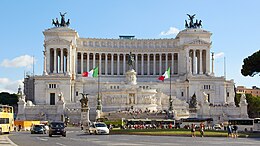
Italy entered into the First World War in 1915 with the aim of completing national unity: for this reason, the Italian intervention is also considered the Fourth Italian War of Independence,[91] from a historiographical perspective that identifies the latter as the conclusion of the unification of Italy.[92]
Italy, nominally allied with the German Empire and the Empire of Austria-Hungary in the Triple Alliance, in 1915 joined the Allies, entering World War I with a promise of substantial territorial gains that included western Inner Carniola, the former Austrian Littoral, and Dalmatia, as well as parts of the Ottoman Empire. The country's contribution to the Allied victory earned it a place as one of the "Big Four" Allied powers. Reorganization of the army and instition of conscription led to Italian victories in major battles. Eventually, in October 1918, the Italians launched a massive offensive, culminating in victory in the Battle of Vittorio Veneto. That victory,[93] marked the end of the war on the Italian Front, secured the dissolution of the Austro-Hungarian Empire, and was instrumental in ending the war less than two weeks later.
During the war, more than 650,000 Italian soldiers and as many civilians died,[94] and the kingdom was on the brink of bankruptcy. The Treaty of Saint-Germain-en-Laye (1919) and the Treaty of Rapallo (1920) allowed for the annexation of Trentino Alto-Adige, the Julian March, Istria, the Kvarner Gulf and the Dalmatian city of Zara. The subsequent Treaty of Rome (1924) led to the annexation of the city of Fiume by Italy. Italy did not receive other territories promised by the Treaty of London, so this outcome was denounced as a "mutilated victory". The rhetoric of "mutilated victory" was adopted by Benito Mussolini, led to the rise of Italian fascism, and became a key point in the propaganda of Fascist Italy. Historians regard "mutilated victory" as a "political myth", used by fascists to fuel Italian imperialism.[95] Italy gained a permanent seat in the League of Nations's executive council.
Fascist regime and World War II
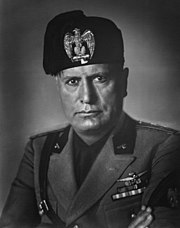
The socialist agitations that followed the devastation of the Great War, inspired by the Russian Revolution, led to counter-revolution and repression throughout Italy. The liberal establishment, fearing a Soviet-style revolution, started to endorse the small National Fascist Party, led by Benito Mussolini. In October 1922, the Blackshirts of the National Fascist Party organized a mass demonstration and the "March on Rome" coup. King Victor Emmanuel III, in October 1922, appointed Mussolini as prime minister, transferring power to the fascists without armed conflict.[96] Mussolini banned all political parties and curtailed personal liberties, thus establishing a dictatorship. These actions attracted international attention and inspired similar dictatorships in Nazi Germany and Francoist Spain.

Fascism was based upon Italian nationalism and imperialism, seeking to expand Italian possessions via irredentist claims based on the legacy of the Roman and Venetian empires.[97] For this reason the Fascist regime engaged in interventionist foreign policy. In 1935, Mussolini invaded Ethiopia and founded Italian East Africa, resulting in international isolation and leading to Italy's withdrawal from the League of Nations. Italy then allied with Nazi Germany and the Empire of Japan, and strongly supported Francisco Franco in the Spanish Civil War. In 1939, Italy formally annexed Albania.
After an initial period of non-belligerence, Italy entered World War II on 10 June 1940. At different times, Italians advanced in British Somaliland, Egypt, the Balkans and eastern fronts. They were, however, defeated on the Eastern Front as well as in the East African and North African campaigns, losing as a result their territories in Africa and the Balkans.
During World War II, Italian war crimes included extrajudicial killings and ethnic cleansing[98] by deportation of about 25,000 people— mainly Yugoslavs— to the Italian concentration camps and elsewhere. Yugoslav Partisans perpetrated their own crimes against the local ethnic Italian population during and after the war, including the foibe massacres. In Italy and Yugoslavia, unlike in Germany, few war crimes were prosecuted.[99]
An Allied invasion of Sicily began in July 1943, leading to the collapse of the Fascist regime and the fall of Mussolini on 25 July. Mussolini was deposed and arrested by order of King Victor Emmanuel III. On 8 September, Italy signed the Armistice of Cassibile, ending its war with the Allies. Shortly thereafter, the Germans, with the assistance of the Italian fascists, succeeded in taking control of northern and central Italy. The country remained a battlefield for the rest of the war, with the Allies slowly moving up from the south.

In the north, the Germans set up the Italian Social Republic (RSI), a Nazi puppet state and collaborationist regime with Mussolini installed as leader after he was rescued by German paratroopers. What remained of the Italian troops was organised into the Italian Co-belligerent Army, which fought alongside the Allies, while other Italian forces, loyal to Mussolini and his RSI, opted to fight alongside the Germans in the National Republican Army. German troops, with the collaboration of the RSI forces, committed several massacres in Italy and deported thousands of Jews to death camps such as Auschwitz. In this context, the post-armistice period saw the emergence of the Italian Resistance (Resistenza), whose fighters fought a guerrilla war against the Nazi German occupiers and the collaborationist Italian Fascist forces.[100] This war of national liberation has been described by as an Italian civil war due to the fighting between partisans and the fascist RSI forces,[101] while the Royalist Italian Co-Belligerent Army was less involved in such clashes.[102] In late April 1945, with total defeat looming, Mussolini attempted to escape north,[103] but was captured and summarily executed near Lake Como by Italian partisans.[104]
Hostilities ended on 29 April 1945, when the German forces in Italy surrendered. Nearly half a million Italians died in the conflict,[105] society was divided, and the economy had been all but destroyed—per capita income in 1944 was at its lowest point since 1900.[106] The aftermath left Italy angry with the monarchy for its endorsement of the Fascist regime. These frustrations contributed to a revival of the Italian republicanism.[107]
Republican era
Italy became a republic after the 1946 Italian institutional referendum[108] held on 2 June, a day celebrated since as Festa della Repubblica. This was the first time women voted at the national level.[109] Victor Emmanuel III's son, Umberto II, was forced to abdicate. The Republican Constitution was approved in 1948. Under the Treaty of Paris between Italy and the Allied Powers, areas next to the Adriatic Sea were annexed by Yugoslavia, resulting in the Istrian-Dalmatian exodus, which involved the emigration of around 300,000 ethnic Italians (Istrian Italians and Dalmatian Italians).[110] Italy lost all colonial possessions, ending the Italian Empire. Italy's border today has existed since 1975, when Trieste was formally re-annexed to Italy.
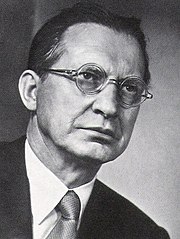
Fears of a Communist takeover proved crucial in 1948, when the Christian Democrats, under Alcide De Gasperi, won a landslide victory.[111] Consequently, in 1949 Italy became a member of NATO. The Marshall Plan revived the economy, which, until the late 1960s, enjoyed a period of economic growth called the Economic Miracle. In the 1950s, Italy became a founding country of the European Communities, a forerunner of the European Union. From the late 1960s until the early 80s, the country experienced the Years of Lead, characterised by economic difficulties, especially after the 1973 oil crisis; social conflicts; and terrorist massacres.[112]
In the 1980s, two governments were led by non-Christian-Democrat premiers: one republican and one socialist; the Christian Democrats remained, however, the main government party. The economy recovered and Italy became the world's fifth-largest industrial nation after it gained entry into the G7 in the 1970s. However national debt skyrocketed past 100% of GDP.
Between 1992-93, Italy faced terror attacks perpetrated by the Sicilian Mafia as a consequence of new anti-mafia measures by the government.[113] A year later, tourist spots were attacked, leaving 10 dead and causing damage to cultural heritage sites such as the Uffizi Gallery. The Church openly condemned the Mafia and an anti-Mafia priest was shot dead in Rome.[114] Voters – disenchanted with political paralysis, massive public debt and extensive corruption uncovered by the Clean Hands investigation – demanded radical reform. The scandals involved all major parties, but especially those in the government coalition: the Christian Democrats, who had ruled for almost 50 years, underwent a crisis and disbanded, splitting into factions.[115] The Communists reorganised as a social-democratic force. During the 1990s and 2000s, centre-right (dominated by media magnate Silvio Berlusconi) and centre-left coalitions (led by professor Romano Prodi) alternately governed.
In 2011, amidst the Great Recession, Berlusconi resigned and was replaced by the technocratic cabinet of Mario Monti.[116] In 2014, PD Matteo Renzi became prime minister and the government started constitutional reform. This was rejected in a 2016 referendum and Paolo Gentiloni became prime minister.[117]

During the European migrant crisis of the 2010s, Italy was the entry point and leading destination for most asylum seekers entering the EU. Between 2013-18, the country took in over 700,000 migrants,[118] mainly from sub-Saharan Africa,[119] which put a strain on the public purse and led to a surge in support for far-right or euro-sceptic parties.[120] The 2018 general election was characterised by a strong showing of the Five Star Movement and the Lega. Giuseppe Conte became prime minister at the head of a populist coalition.[121] After only fourteen months the League withdrew its support from Conte, who formed a new coalition of the Five Star Movement and the centre-left.[122]
In 2020, Italy was severely hit by Covid;[123] the government imposed a national lockdown.[124] With more than 155,000 victims, Italy was one of the countries with the most deaths in the pandemic[125] and one of the most affected economically.[126] In February 2021, after a government crisis within his majority, Conte was forced to resign. Mario Draghi, former president of the European Central Bank, formed a national unity government supported by most main parties,[127] pledging to implement economic stimulus to face the crisis caused by the pandemic.[128] In October 2022, Giorgia Meloni was sworn in as Italy's first female prime minister. Her Brothers of Italy party formed a right-wing government with the far-right League and Berlusconi's Forza Italia.[129]
Geography

Italy, whose territory largely coincides with the eponymous geographical region,[16] is located in Southern Europe (and is also considered part of western Europe[14]) between latitudes 35° and 47° N, and longitudes 6° and 19° E. To the north, from west to east, Italy borders France, Switzerland, Austria, and Slovenia, and is roughly delimited by the Alpine watershed, enclosing the Po Valley and the Venetian Plain. It consists of the entirety of the Italian Peninsula and the two Mediterranean islands of Sicily and Sardinia (the biggest islands of the Mediterranean), in addition to many smaller islands. Some of Italy's territory extends beyond the Alpine basin, and some islands are located outside the Eurasian continental shelf. These territories are the comuni of: Livigno, Sexten, Innichen, Toblach, Chiusaforte, Tarvisio, Graun im Vinschgau, which are part of the Danube's drainage basin, while the Val di Lei constitutes part of the Rhine's basin and the islands of Lampedusa and Lampione are on the African continental shelf.
The country's total area is 301,230 square kilometres (116,306 sq mi), of which 294,020 km2 (113,522 sq mi) is land and 7,210 km2 (2,784 sq mi) is water.[130] Including the islands, Italy has a coastline of 7,600 kilometres (4,722 miles) on the Mediterranean Sea, the Ligurian and Tyrrhenian seas,[131] the Ionian Sea,[132] and the Adriatic Sea.[133] Its border with France runs for 488 km (303 mi); Switzerland, 740 km (460 mi); Austria, 430 km (267 mi); and Slovenia, 232 km (144 mi). The sovereign states of San Marino and Vatican City are enclaves within Italy,[134] while Campione d'Italia is an Italian exclave in Switzerland.[135] The border with San Marino is 39 km (24 mi) long, that with Vatican City, 3.2 km (2.0 mi).[130]
Over 35% of Italian territory is mountainous.[136] The Apennine Mountains form the peninsula's backbone, and the Alps form most of its northern boundary, where Italy's highest point is located on the summit of Mont Blanc (Monte Bianco) at 4,810 m (15,780 ft). Other well-known mountains include the Matterhorn (Monte Cervino), Monte Rosa, Gran Paradiso in the western Alps, and Bernina, Stelvio and the Dolomites in the eastern Alps. Many parts of Italian territory are of volcanic origin. Most small islands and archipelagos in the south are volcanic islands. There are active volcanoes: Mount Etna in Sicily (the largest active volcano in Europe), Vulcano, Stromboli, and Vesuvius.
Most of the rivers of Italy drain either into the Adriatic or Tyrrhenian Sea.[137] The longest river is the Po, which flows, for either 652 km (405 mi) or 682 km (424 mi), from the Alps on the western border with France, and crosses the Padan plain on its way to the Adriatic.[138] The Po Valley is the largest plain, with 46,000 km2 (18,000 sq mi), and contains over 70% of the country's lowlands.[136] The five largest lakes are, in descending size: Garda (367.94 km2 or 142 sq mi), Maggiore (212.51 km2 or 82 sq mi, Como (145.9 km2 or 56 sq mi), Trasimeno (124.29 km2 or 48 sq mi) and Bolsena (113.55 km2 or 44 sq mi).[139]
Climate
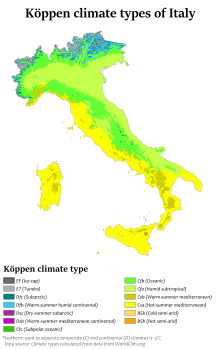
The climate is influenced by the large seas that surrounds Italy on every side except the north. These seas constitute a reservoir of heat and humidity. Within the southern temperate zone, they determine a Mediterranean climate with local differences due to the geomorphology of the territory, which tends to make its mitigating effects felt, especially under high-pressure conditions.[141]
Because of the length of the peninsula and the mostly mountainous hinterland, the climate is highly diverse. In most inland northern and central regions, the climate ranges from humid subtropical to humid continental and oceanic. The climate of the Po valley is mostly humid subtropical, with cool winters and hot summers.[142] The coastal areas of Liguria, Tuscany, and most of the South generally fit the Mediterranean climate stereotype, as in the Köppen climate classification.
Conditions on the coast are different from those in the interior, particularly during winter when the higher altitudes tend to be cold, wet, and often snowy. The coastal regions have mild winters, and hot and generally dry summers; lowland valleys are hot in summer. Average winter temperatures vary from around 0 °C (32 °F) in the Alps to 12 °C (54 °F) in Sicily; so, average summer temperatures range from 20 °C (68 °F) to over 25 °C (77 °F).
Winters can vary widely with lingering cold, foggy, and snowy periods in the north, and milder, sunnier conditions in the south. Summers are hot across the country, except at high altitude, particularly in the south. Northern and central areas can experience strong thunderstorms from spring to autumn.[143]
Biodiversity
Italy's varied geography, including the Alps, the Apennines, central Italian woodlands, and southern Italian Garigue and Maquis shrubland, contribute to climatic and habitat diversity. As the peninsula is in the centre of the Mediterranean, forming a corridor between central Europe and North Africa, and having 8,000 km (5,000 mi) of coastline, Italy has received species from the Balkans, Eurasia, and the Middle East. Italy has probably the highest level of faunal biodiversity in Europe, with over 57,000 species recorded, representing more than a third of all European fauna,[144] and the highest level of biodiversity of animal and plant species within the EU.[145]
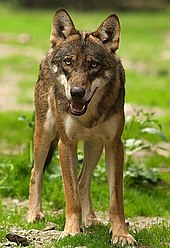
The fauna of Italy includes 4,777 endemic animal species,[146] which include the Sardinian long-eared bat, Sardinian red deer, spectacled salamander, brown cave salamander, Italian newt, Italian frog, Apennine yellow-bellied toad, Italian wall lizard and Sicilian pond turtle. There are 119 mammals species,[147] 550 bird species,[148] 69 reptile species,[149] 39 amphibian species,[150] 623 fish species,[151] and 56,213 invertebrate species, of which 37,303 are insect species.[152]
The flora of Italy was traditionally estimated to comprise about 5,500 vascular plant species.[153] However, as of 2005[update], 6,759 species are recorded in the Data bank of Italian vascular flora.[154] Italy has 1,371 endemic plant species and subspecies,[155] which include Sicilian fir, Barbaricina columbine, Sea marigold, Lavender cotton, and Ucriana violet. Italy is a signatory to the Berne Convention on the Conservation of European Wildlife and Natural Habitats and the Habitats Directive.
Italy has many botanical and historic gardens.[156] The Italian garden is stylistically based on symmetry, axial geometry, and the principle of imposing order on nature. It influenced the history of gardening, especially French and English gardens.[157] The Italian garden was influenced by Roman and Italian Renaissance gardens.
The Italian wolf is the national animal of Italy,[158] while the national tree is the strawberry tree.[159] The reasons for this are that the Italian wolf, which inhabits the Apennine Mountains and the Western Alps, features prominently in Latin and Italian cultures, such as the legend of the founding of Rome,[160] while the green leaves, white flowers and red berries of the strawberry tree, native to the Mediterranean, recall the colours of the flag.[159]
Environment
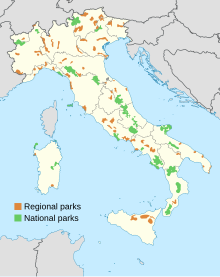
After its quick industrial growth, Italy took a long time to address its environmental problems. After several improvements, Italy now ranks 84th in the world for ecological sustainability.[161] National parks cover about 5% of the country,[162] while the total area protected by national parks, regional parks, and nature reserves covers about 11% of Italian territory,[163] and 12% of Italy's coastline is protected.[164]
Italy has been one of the world's leading producers of renewable energy, in 2010 ranking as the fourth largest provider of installed solar energy capacity[165] and sixth largest of wind power capacity.[166] Renewable energy provided approximately 37% Italy's energy consumption in 2020.[167]
The country operated nuclear reactors between 1963-90 but, after the Chernobyl disaster and referendums, the nuclear programme was terminated, a decision overturned by the government in 2008, with plans to build up to four nuclear power plants. This was in turn struck down by a referendum following the Fukushima nuclear accident.[168]

Air pollution remains severe, especially in the industrialised north. Italy is the twelfth-largest carbon dioxide producer.[169] Extensive traffic and congestion in large cities continue to cause environmental and health issues, even if smog levels have decreased since the 1970s and 1980s, with smog becoming an increasingly rare phenomenon and levels of sulphur dioxide decreasing.[170]
Many watercourses and stretches of coast have been contaminated by industrial and agricultural activity, while, because of rising water levels, Venice has experienced regular, intermittent flooding in recent years. Waste is not always disposed legally and has led to permanent adverse health effects on some inhabitants, as in the case of the Seveso disaster.
Deforestation, illegal building, and poor land-management policies have led to significant erosion in Italy's mountainous regions, leading to ecological disasters such as the 1963 Vajont Dam flood, and the 1998 Sarno[171] and 2009 Messina mudslides. The country had a 2019 Forest Landscape Integrity Index mean score of 3.65/10, ranking it 142nd globally out of 172 countries.[172]
Politics
Italy has been a unitary parliamentary republic since 1946, when the monarchy was abolished by a constitutional referendum. The President of Italy, Sergio Mattarella since 2015, is Italy's head of state. The president is elected for a single seven-year term by the Italian Parliament and regional voters in joint session. Italy has a written democratic constitution that resulted from a Constituent Assembly formed by representatives of the anti-fascist forces that contributed to the defeat of Nazi and Fascist forces during the liberation of Italy, in World War II and the Italian civil war.[173]
Government
Italy has a parliamentary government based on a mixed proportional and majoritarian voting system. The parliament is perfectly bicameral, each house with the same powers. The two houses: the Chamber of Deputies meets in Palazzo Montecitorio, and the Senate of the Republic meets in Palazzo Madama. A peculiarity of the Italian Parliament is the representation given to Italian citizens permanently living abroad: 8 Deputies and 4 Senators are elected in four distinct overseas constituencies. The Senate is also characterised by a small number of senators for life, appointed by the president "for outstanding patriotic merits in the social, scientific, artistic or literary field". Former presidents are ex officio life senators.
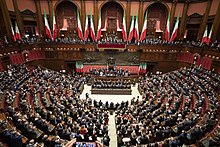
The prime minister, officially the President of the Council of Ministers, is head of government and has executive authority but must receive a vote of approval from the Council of Ministers to execute most policies. The prime minister and the cabinet are appointed by the President and confirmed by a vote of confidence in parliament. To remain as prime minister, one also has to pass votes of confidence. The role of prime minister is similar to most other parliamentary systems; but in Italy, the prime minister is not authorised to request the dissolution of parliament. Another difference, from similar offices, is that in Italy the political responsibility for intelligence is with the prime minister. The prime minister has exclusive power to coordinate intelligence policies, determine the financial resources, and strengthen national cyber security; apply and protect State secrets; and to authorise agents to carry out operations, in Italy or abroad.[174]
Italy's three major political parties are the Brothers of Italy, the Democratic Party, and the Five Star Movement. During the 2022 general election, these three and their coalitions won 357 out of the 400 seats in the Chamber of Deputies, and 187 out of 200 in the Senate. The centre-right coalition which included: Giorgia Meloni's Brothers of Italy, Matteo Salvini's League, Silvio Berlusconi's Forza Italia, and Maurizio Lupi's Us Moderates, won a majority of the seats in parliament. The rest were taken by the centre-left coalition which included: Enrico Letta's Democratic Party, Angelo Bonelli's Greens and Left Alliance, Aosta Valley, Emma Bonino's More Europe, and Luigi Di Maio's Civic Commitment, as well as Giuseppe Conte's Five Star Movement, Carlo Calenda's Action – Italia Viva, Philipp Achammer and Philipp Achammer's South Tyrolean People's Party, Cateno De Luca's South Calls North, and Ricardo Antonio Merlo's Associative Movement of Italians Abroad.
Law and criminal justice

The law of Italy has several sources. These are hierarchical: the law or regulation from a lower source cannot conflict with the rule of an upper source (hierarchy of sources).[175] The Constitution of 1948 is the highest source.[176] The Constitutional Court of Italy rules on the conformity of laws with the constitution. The judiciary bases their decisions on Roman law modified by the Napoleonic Code and later statutes. The Supreme Court of Cassation is the highest court for both criminal and civil appeals.
Italy lags behind other Western European nations in LGBT rights.[177] Italy's law prohibiting torture is considered behind international standards.[178]
The Italian law enforcement system is complex with multiple police forces.[179] The national policing agencies are the Polizia di Stato (State Police), the Arma dei Carabinieri, the Guardia di Finanza (Financial Police), and the Polizia Penitenziaria (Prison Police),[180] as well as the Guardia Costiera (Coast Guard Police).[179] Although policing is primarily provided on a national basis,[180] there also exists the Polizia Provinciale (Provincial Police) and the Polizia Municipale (Municipal Police).[179]
Since their appearance in the middle of the 19th century, Italian organised crime and criminal organisations have infiltrated the social and economic life of many regions in Southern Italy; the most notorious is the Sicilian Mafia, which expanded into foreign countries including the US. Mafia receipts may reach 9%[181] of GDP.[182] A 2009 report identified 610 comuni which have a strong Mafia presence, where 13 million Italians live and 15% of GDP is produced.[183] The Calabrian 'Ndrangheta, probably the most powerful crime syndicate of Italy, accounts alone for 3% of GDP.[184]
However, at 0.013 per 1,000 people, Italy has only the 47th highest murder rate,[185] compared to 61 countries, and the 43rd highest number of rapes per 1,000 people, compared to 64 countries in the world. These are relatively low figures among developed countries.
Foreign relations

Italy is a founding member of the European Economic Community (EEC), now the European Union (EU), and of NATO. Italy was admitted to the United Nations in 1955, and is a member and strong supporter of international organisations, such as the OECD, the General Agreement on Tariffs and Trade/World Trade Organization (GATT/WTO), the Organization for Security and Co-operation in Europe (OSCE), the Council of Europe, and the Central European Initiative. Its turns in the rotating presidencies of international organisations include the Organization for Security and Co-operation in Europe in 2018, G7 in 2017, and the EU Council in 2014. Italy is a recurrent non-permanent member of the UN Security Council.
Italy strongly supports multilateral international politics, endorsing the UN and its international security activities. In 2013, Italy had 5,296 troops deployed abroad, engaged in 33 UN and NATO missions in 25 countries.[186] Italy deployed troops in support of UN peacekeeping missions in Somalia, Mozambique, and East Timor. Italy provides support for NATO and UN operations in Bosnia, Kosovo, and Albania, and deployed over 2,000 troops to Afghanistan in support of Operation Enduring Freedom (OEF) from 2003.
Italy supported international efforts to reconstruct and stabilise Iraq, but it had withdrawn its military contingent of 3,200 troops by 2006. In August 2006, Italy deployed about 2,450 troops in Lebanon for the UN peacekeeping mission UNIFIL.[187] Italy is one of the largest financiers of the Palestinian National Authority, contributing €60 million in 2013 alone.[188]
Military

The Italian Army, Navy, Air Force, and Carabinieri collectively form the Italian Armed Forces, under the command of the High Council of Defence, presided over by the President, per the Constitution of Italy. According to article 78, the Parliament has the authority to declare a state of war and vest the necessary war-making powers in the government.
Despite not being a branch of the armed forces, the Guardia di Finanza has military status and is organized along military lines.[e] Since 2005, military service has been voluntary.[189] In 2010, the Italian military had 293,202 personnel on active duty,[190] of which 114,778 are Carabinieri.[191] As part of NATO's nuclear sharing strategy, Italy hosts 90 US B61 nuclear bombs located at the Ghedi and Aviano air bases.[192]
The Army is the national ground defence force. It was formed in 1946, when Italy became a republic, from what remained of the Regio Esercito (the "Royal Army"). Its best-known combat vehicles are the Dardo infantry fighting vehicle, the Centauro tank destroyer, and the Ariete tank, and among its aircraft are the Mangusta attack helicopter, deployed on EU, NATO, and UN missions. It has at its disposal Leopard 1 and M113 armoured vehicles.
The Italian Navy is a blue-water navy. It was also formed in 1946 from what remained of the Regia Marina (the "Royal Navy"). The Navy, being a member of the EU and NATO, has taken part in coalition peacekeeping operations around the world. In 2014, the Navy operated 154 vessels in service, including minor auxiliary vessels.[193]
The Italian Air Force was founded as an independent service arm in 1923 by King Victor Emmanuel III as the Regia Aeronautica ("Royal Air Force"). After World War II, it was renamed as the Regia Aeronautica. In 2021, the Italian Air Force operated 219 combat jets. A transport capability is guaranteed by a fleet of 27 C-130Js and C-27J Spartan. The acrobatic display team is the Frecce Tricolori ("Tricolour Arrows").
An autonomous corps of the military, the Carabinieri are the gendarmerie and military police of Italy, policing the military and civilian population alongside Italy's other police forces. While different branches of the Carabinieri report to separate ministries, the corps reports to the Ministry of Internal Affairs when maintaining public order and security.[194]
Administrative divisions
Italy is constituted of 20 regions (regioni)—five of which have special autonomous status which enables them to enact legislation on additional matters.[195]
The regioni contain 107 provinces (province) or metropolitan cities (città metropolitane), and 7,904 municipalities (comuni).[195]
Demographics
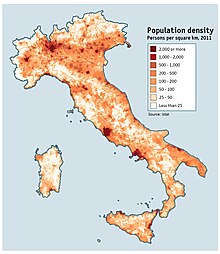
In 2020, Italy had 60,317,116 inhabitants.[196] The population density, of 202 inhabitants per square kilometre (520/sq mi), is higher than most West European countries. However, distribution is uneven. The most densely populated areas are the Po Valley (almost half the population) and the metropolitan areas of Rome and Naples, while vast regions such as the Alps and Apennine highlands, the plateaus of Basilicata, and the island of Sardinia, as well as much of Sicily, are sparsely populated.
The population almost doubled during the 20th century, but the pattern of growth was uneven because of large-scale internal migration from the rural South to the industrial North, a consequence of the Italian economic miracle of the 1950–1960s. High fertility and birth rates persisted until the 1970s, after which they started to decline. The population rapidly aged; by 2010, one in five Italians was over 65, and the country has the fifth oldest population in the world, with a median age of 48.[197][198] However, Italy has experienced significant growth in birth rates.[199] The total fertility rate climbed from an all-time low of 1.2 children per woman in 1995 to 1.4 in 2008,[200] albeit still below the replacement rate of 2.1 and considerably below the high of 5 in 1883.[201] Nevertheless, the rate is expected to reach 1.6–1.8 in 2030.[202]
From the late 19th century to the 1960s, Italy was a country of mass emigration. Between 1898-1914, the peak years of Italian diaspora, approximately 750,000 Italians emigrated annually.[203] The diaspora included more than 25 million Italians and is considered the greatest mass migration of recent times.[204] As a result, today more than 4 million Italian citizens live abroad,[205] while at least 60 million people of full or part Italian ancestry live outside of Italy, most notably in Argentina,[206] Brazil,[207] Uruguay,[208] Venezuela,[209] the US,[210] Canada,[211] Australia,[212] and France.[213]
Largest cities
| Rank | Name | Region | Municipal pop. | Rank | Name | Region | Pop. | ||
|---|---|---|---|---|---|---|---|---|---|
 Rome  Milan | 1 | Rome | Lazio | 2,748,109 | 11 | Verona | Veneto | 255,588 |  Naples  Turin |
| 2 | Milan | Lombardy | 1,354,196 | 12 | Venice | Veneto | 250,369 | ||
| 3 | Naples | Campania | 913,462 | 13 | Messina | Sicily | 218,786 | ||
| 4 | Turin | Piedmont | 841,600 | 14 | Padua | Veneto | 206,496 | ||
| 5 | Palermo | Sicily | 630,167 | 15 | Trieste | Friuli-Venezia Giulia | 198,417 | ||
| 6 | Genoa | Liguria | 558,745 | 16 | Parma | Emilia-Romagna | 196,885 | ||
| 7 | Bologna | Emilia-Romagna | 387,971 | 17 | Brescia | Lombardy | 196,567 | ||
| 8 | Florence | Tuscany | 360,930 | 18 | Prato | Tuscany | 195,820 | ||
| 9 | Bari | Apulia | 316,015 | 19 | Taranto | Apulia | 188,098 | ||
| 10 | Catania | Sicily | 298,762 | 20 | Modena | Emilia-Romagna | 184,153 | ||
Immigration
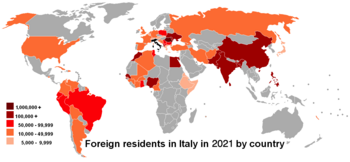
In the early 1980s, until then a linguistically and culturally homogeneous society, Italy began to attract substantial flows of immigrants.[214] After the fall of the Berlin Wall, and enlargements of the EU, waves of migration originated from the former socialist countries of East Europe. Another source of immigration is neighbouring North Africa, with arrivals soaring as a consequence of the Arab Spring. Growing migration fluxes from Asia-Pacific (notably China[215] and the Philippines) and Latin America have been recorded.
As of 2010, the foreign-born population was from the following regions: Europe (54%), Africa (22%), Asia (16%), the Americas (8%), and Oceania (0.06%). The distribution of the foreign population is geographically varied: in 2020, 61% of foreign citizens lived in the north, 24% in the centre, 11% in the south, and 4% on the islands.[216]
In 2021, Italy had about 5.2 million foreign residents,[1][217] making up 9% of the population. The figures include more than half a million children born in Italy to foreign nationals but exclude foreign nationals who have subsequently acquired Italian citizenship;[218] in 2016, about 201,000 people became Italian citizens.[219] The official figures also exclude illegal immigrants, which was estimated to be 670,000 as of 2008.[220] About one million Romanian citizens are registered as living in Italy, representing the largest migrant population.
Languages

Italy's official language is Italian.[221][222] There are an estimated 64 million native Italian speakers around the world,[223] and another 21 million use it as a second language.[224] Italian is often natively spoken as a regional dialect, not to be confused with Italy's regional and minority languages;[225] however, during the 20th century, the establishment of a national education system led to a decrease in regional dialects. Standardisation was further expanded in the 1950s and 1960s, due to economic growth and the rise of mass media and television.
Twelve "historical minority languages" are formally recognised: Albanian, Catalan, German, Greek, Slovene, Croatian, French, Franco-Provençal, Friulian, Ladin, Occitan, and Sardinian.[221] Four of these enjoy co-official status in their respective regions: French in the Aosta Valley;[226] German in South Tyrol, and Ladin as well in some parts of the same province and in parts of the neighbouring Trentino;[227] and Slovene in the provinces of Trieste, Gorizia and Udine.[228] Other Ethnologue, ISO, and UNESCO languages are not recognised under Italian law. Like France, Italy has signed the European Charter for Regional or Minority Languages, but has not ratified it.[229]
Due to recent immigration, Italy has sizeable populations whose native language is not Italian, nor a regional language. According to the Italian National Institute of Statistics, Romanian is the most common mother tongue among foreign residents: almost 800,000 people speak Romanian as their first language (22% of foreign residents aged 6 and over). Other prevalent mother tongues are Arabic (spoken by over 475,000; 13% of foreign residents), Albanian (380,000), and Spanish (255,000).[230]
Religion
Religion in Italy according to the Ipsos survey, 2023 (approximately 1000 participants)[231]
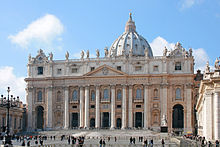
The Holy See, the episcopal jurisdiction of Rome, contains the central government of the Catholic Church. It is recognised by other subjects of international law as a sovereign entity, headed by the Pope, who is also the Bishop of Rome, with which diplomatic relations can be maintained.[232][f] Often incorrectly referred to as "the Vatican", the Holy See is not the same entity as the Vatican City State because the Holy See is the jurisdiction and administrative entity of the Pope.[233]
Although it has been historically characterized by the dominance of Catholicism since the Great Schism, Religiosity in Italy is declining.[234] Most Catholics are nominal; the Associated Press describes Italian Catholicism as "a faith that's... nominally embraced but rarely lived."[234] Italy has the world's fifth-largest Catholic population, the largest in Europe.[235] Since 1985, Catholicism is no longer the official state religion.[236]
In 2011, minority Christian faiths in Italy included an estimated 1.5 million Orthodox Christians. Protestantism has been growing.[237] One of the longest-established minority religious faiths is Judaism. Italy has for centuries welcomed Jews expelled from other countries, notably Spain. However, about 20% of Italian Jews were killed during the Holocaust.[238] This, together with the emigration which preceded and followed World War II, has left only around 28,000 Jews in Italy.[239] There are 120,000 Hindus[240] and 70,000 Sikhs.[241]
The Italian state devolves shares of income tax to recognised religious communities, under a regime known as eight per thousand. Donations are allowed to Christian, Jewish, Buddhist, and Hindu communities; however, Islam remains excluded, since no Muslim communities have signed a concordat with the state.[242] Taxpayers who do not wish to fund a religion contribute their share to the state welfare system.[243]
Education
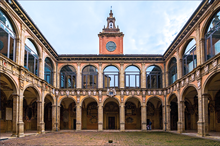
Education is mandatory and free from ages six to sixteen,[244] and consists of five stages: kindergarten, primary school, lower secondary school, upper secondary school, and university.[245]
Primary school lasts eight years. Students are given a basic education in Italian, English, mathematics, natural sciences, history, geography, social studies, physical education, and visual and musical arts. Secondary school lasts for five years and includes three traditional types of schools focused on different academic levels: the liceo prepares students for university studies with a classical or scientific curriculum, while the istituto tecnico and the istituto professionale prepare pupils for vocations.
In 2018, secondary education was evaluated as being below the average among OECD countries.[246] Italy scored below the OECD average in reading and science, and near the OECD average in maths.[246] Compared to school children in other OECD countries, children missed out on a greater amount of learning due to absences and indiscipline in classrooms.[247] A wide gap exists between northern schools, which perform near average, and the south, which had much poorer results.[248]
Tertiary education is divided between public universities, private universities, and the prestigious and selective superior graduate schools, such as the Scuola Normale Superiore di Pisa. 33 Italian universities were ranked among the world's top 500 in 2019.[249] Bologna University, founded in 1088, is the oldest university still in operation,[250] and one of the leading academic institutions in Europe.[251] Bocconi University, the Università Cattolica del Sacro Cuore, LUISS, the Polytechnic University of Turin, the Polytechnic University of Milan, the Sapienza University of Rome, and the University of Milan are also ranked among the best.[252]
Health

Life expectancy is 80 for men and 85 for women, placing the country 5th in the world.[254] Compared to other Western countries, Italy has a low rate of adult obesity (below 10%[255]), as there are health benefits of the Mediterranean diet.[256] In 2013, UNESCO, prompted by Italy, added the Mediterranean diet to the Representative List of the Intangible Cultural Heritage of Humanity of Italy, Morocco, Spain, Portugal, Greece, Cyprus, and Croatia.[257] The proportion of daily smokers was 22% in 2012, down from 24% in 2000 but above the OECD average.[258] Since 2005, smoking in public places has been restricted to "specially ventilated rooms".[259]
Since 1978, the state has run a universal public healthcare system.[260] However, healthcare is provided to all citizens and residents by a mixed public-private system. The public part is the Servizio Sanitario Nazionale, which is organised under the Ministry of Health and administered on a devolved regional basis. Healthcare spending accounted for 10% of GDP in 2020.[261] Italy's healthcare system has been consistently ranked among the best in the world.[262] However, in 2018 Italy's healthcare was ranked 20th in Europe by the Euro health consumer index.
Economy

Italy has an advanced[263] capitalist mixed economy that ranks as the third-largest in the eurozone and the eighth-largest in the world by nominal GDP.[264] It has the ninth-largest national wealth and the third-largest central bank gold reserve. As a founding member of the G7, the eurozone, and the OECD, it is one of the most industrialised nations and a leading country in world trade and exports.[265] It is a developed country ranked 30th on the Human Development Index. It performs well in life expectancy, healthcare[266] and education. The country is well known for its creative and innovative businesses,[267] a competitive agricultural sector[268] (with the world's largest wine production),[269] and for its influential and high-quality automobile, machinery, food, design, and fashion industries.[270]
Italy is the sixth-largest manufacturing country,[271] characterised by fewer global multinational corporations than other economies of comparable size and many dynamic small and medium-sized enterprises, clustered in industrial districts, which are the backbone of Italian industry. This has produced a niche markets manufacturing sector often focused on the export of luxury products. Although less capable of competing on quantity, it is more capable of competing with China, and other Asian economies which offer products with lower labour costs, through its higher-quality products.[272] Italy was the world's tenth-largest exporter in 2019. Its closest trade ties are with other EU countries. Its largest export partners in 2019 were Germany (12%), France (11%), and the US (10%).[197]

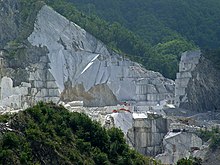
The automotive industry is a significant part of the manufacturing sector with over 144,000 firms and almost 485,000 employees in 2015,[274] and a contributing 9% to GDP.[275] Stellantis is the world's fifth-largest auto maker.[276] The country boasts a wide range of products, from city cars to luxury supercars such as Maserati, Pagani, Lamborghini, and Ferrari.[277]
The Banca Monte dei Paschi di Siena is the world's oldest or second oldest bank in continuous operation, depending on the definition, and the fourth-largest Italian commercial and retail bank.[278] Italy has a strong cooperative sector with the largest share in the EU of the population (4.5%) employed by a cooperative.[279] The Val d'Agri area, Basilicata, hosts the largest onshore hydrocarbon field in Europe.[280] Moderate natural gas reserves, mainly in the Po Valley and offshore under the Adriatic, have been discovered and constitute the country's most important mineral resource. Italy is one of the world's leading producers of pumice, pozzolana, and feldspar.[281] Another notable resource is marble, especially the world-famous white Carrara marble from the Massa and Carrara quarries in Tuscany.
Italy is part of a monetary union, the eurozone, which represents around 330 million citizens, and of the European single market, which represents more than 500 million consumers. Several domestic commercial policies are determined by agreements among EU members and EU legislation. Italy joined the common European currency, the euro, in 2002.[282] Its monetary policy is set by the European Central Bank.
Italy was hit hard by the financial crisis of 2007–08, which exacerbated structural problems.[283] After strong GDP growth of 5–6% per year from the 1950s to the early 1970s,[284] and a progressive slowdown in the 1980–90s, the country virtually stagnated in the 2000s.[285] Political efforts to revive growth with massive government spending eventually produced a severe rise in public debt, that stood at over 132% of GDP in 2017,[286] the second highest in the EU, after Greece.[287] The largest portion of Italian public debt is owned by national subjects, a major difference between Italy and Greece,[288] and the level of household debt is much lower than the OECD average.[289]
A gaping North–South divide is a major factor of socio-economic weakness,[290] there is a huge difference in official income between northern and southern regions and municipalities.[291] The richest province, Alto Adige-South Tyrol, earns 152% of the national GDP per capita, while the poorest region, Calabria earns 61%.[292] The unemployment rate (11%) is above the eurozone average,[293] but the disaggregated figure is 6.6% in the North and 19% in the South.[294] The youth unemployment rate (32% in 2018) is extremely high.
Agriculture
According to the last national agricultural census, there were 1.6 million farms in 2010 (−32.4% since 2000) covering 12,700,000 ha or 31,382,383 acres (63% of which are located in South Italy).[296] The vast majority (99%) are family-operated and small, averaging only 8 ha (20 acres) in size.[296] Of the total area in agricultural use (forestry excluded), grain fields take up 31%, olive tree orchards 8%, vineyards 5.4%, citrus orchards 4%, sugar beets 1.7%, and horticulture 2.4%. The remainder is primarily dedicated to pastures (26%) and feed grains (12%).[296]
Italy is the world's largest wine producer,[297] and one of the leading producers of olive oil, fruits (apples, olives, grapes, oranges, lemons, pears, apricots, hazelnuts, peaches, cherries, plums, strawberries, and kiwifruits), and vegetables (especially artichokes and tomatoes). The most famous Italian wines are the Tuscan Chianti and the Piedmontese Barolo. Other famous wines are Barbaresco, Barbera d'Asti, Brunello di Montalcino, Frascati, Montepulciano d'Abruzzo, Morellino di Scansano, and the sparkling wines Franciacorta and Prosecco.
Quality goods in which Italy specialises, particularly wines and regional cheeses, are often protected under the quality assurance labels DOC/DOP. This geographical indication certificate, which is accredited by the EU, is considered important to avoid confusion with low-quality mass-produced ersatz products.
Transport

Italy was the first country to build motorways, the so-called autostrade, reserved for fast traffic and motor vehicles only.[299] Regarding the national road network, in 2002 there were 668,721 km (415,524 mi) of serviceable roads in Italy, including 6,487 km (4,031 mi) of motorways, state-owned but privately operated by Atlantia. In 2005, about 34,667,000 passenger cars (590 per 1,000 people) and 4,015,000 goods vehicles circulated on the national road network.[300]
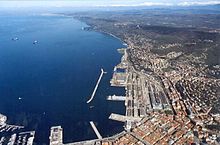
The national railway network, state-owned and operated by Rete Ferroviaria Italiana (FSI), in 2008 totalled 16,529 km (10,271 mi) of which 11,727 km (7,287 mi) is electrified, and on which 4,802 locomotives and railcars run. The main public operator of high-speed trains is Trenitalia, part of FSI. High-speed trains are divided into three categories: Frecciarossa (red arrow) trains operate at a maximum 300 km/h on dedicated high-speed tracks; Frecciargento (silver arrow) trains operate at a maximum 250 km/h on high-speed and mainline tracks; and Frecciabianca (white arrow) trains operate on high-speed regional lines at a maximum 200 km/h. Italy has 11 rail border crossings over the Alpine mountains with neighbouring countries.
Italy is fifth in Europe by number of passengers using air transport, with about 148 million passengers or about 10% of the European total in 2011.[301] In 2022, there were 45 civil airports, including the hubs of Malpensa International Airport in Milan and Leonardo da Vinci International Airport in Rome.[302] Since October 2021, Italy's flag carrier airline has been ITA Airways, which took over the brand, IATA ticketing code, and assets belonging to the former flag carrier Alitalia, after its bankruptcy.[303]
In 2004, there were 43 major seaports, including Genoa, the country's largest and second-largest in the Mediterranean. In 2005 Italy maintained a civilian air fleet of about 389,000 units and a merchant fleet of 581 ships.[300] The national inland waterways network had a length of 2,400 km (1,491 mi) for commercial traffic in 2012.[197]
Italy has been the final destination of the Silk Road for many centuries. In particular, the construction of the Suez Canal intensified sea trade with East Africa and Asia from the 19th century. Since the end of the Cold War and with increasing European integration, trade relations, often interrupted in the 20th century, have intensified again. North Italian ports such as the deep-water port of Trieste, with its extensive rail connections to Central and Eastern Europe are again the destination of subsidies and significant foreign investment.[304]
Energy
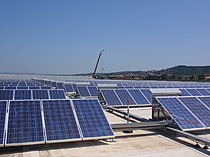
Italy has become one of the world's largest producers of renewable energy, ranking as the second largest producer in the EU and the ninth in the world. Wind power, hydroelectricity, and geothermal power are significant sources of electricity in the country. Renewable sources account for 28% of all electricity produced, with hydro alone reaching 13%, followed by solar at 6%, wind at 4%, bioenergy at 3.5%, and geothermal at 1.6%.[306] The rest of the national demand is supplied by fossil fuels (natural gas 38%, coal 13%, oil 8%) and imports.[306] Eni, operating in 79 countries, is one of the seven "Supermajor" oil companies, and one of the world's largest industrial companies.[307]
Solar energy production alone accounted for 9% of electricity in 2014, making Italy the country with the highest contribution from solar energy in the world.[305] The Montalto di Castro Photovoltaic Power Station, completed in 2010, is the largest photovoltaic (PV) power station in Italy with 85 MW.[308] Italy was the first country to exploit geothermal energy to produce electricity.[309] Italy managed four nuclear reactors until the 1980s. However, nuclear power in Italy was abandoned after 1987 referendums (in the wake of the 1986 Chernobyl disaster), though Italy still imports nuclear energy from Italy-owned reactors in foreign territories.
Science and technology


Through the centuries, Italy has fostered a scientific community that produced major discoveries the sciences. During the Renaissance, Italian polymaths such as da Vinci, Michelangelo, and Leon Battista Alberti made contributions in a variety of fields, including biology, architecture, and engineering. Galileo Galilei, an astronomer, physicist, and engineer, played a major role in the Scientific Revolution. He is considered the "father" of observational astronomy,[310] modern physics,[311][312] and the scientific method.[313][314]
Other astronomers, such as Giovanni Domenico Cassini and Giovanni Schiaparelli, made discoveries about the Solar System. In mathematics, Joseph Louis Lagrange was active before leaving Italy. Fibonacci and Gerolamo Cardano made fundamental advances in maths.[316] Luca Pacioli established accounting principles. Physicist Enrico Fermi, a Nobel prize laureate, led the team in Chicago that developed the first nuclear reactor. He is considered an "architect of the atomic bomb".[315] Italian physicists Emilio G. Segrè, who discovered the elements technetium and astatine, and the antiproton; Bruno Rossi, a pioneer in Cosmic Rays and X-ray astronomy; and other physicists were forced to leave Italy in the 1930s due to Fascist laws against Jews.[317]
Other prominent physicists include Amedeo Avogadro (most noted for his contributions to molecular theory), Evangelista Torricelli (inventor of the barometer), Alessandro Volta (inventor of the electric battery), Guglielmo Marconi (inventor of radio), Galileo Ferraris and Antonio Pacinotti, pioneers of the induction motor, Alessandro Cruto (pioneer of the light bulb), and Innocenzo Manzetti (pioneer of automatons and robotics), Ettore Majorana (who discovered the Majorana fermions), Carlo Rubbia (1984 Nobel Prize laureate in physics), and Antonio Meucci (for developing a voice-communication device sometimes credited as the first telephone).[318] In 1964, Pier Giorgio Perotto designed one of the first desktop programmable calculators, the Programma 101.[319]
In biology, Francesco Redi was the first to challenge the theory of spontaneous generation by demonstrating that maggots come from eggs of flies. Marcello Malpighi founded microscopic anatomy. Lazzaro Spallanzani conducted research in bodily functions, animal reproduction, and cellular theory. Camillo Golgi, whose many achievements include the discovery of the Golgi complex. Rita Levi-Montalcini, who discovered the nerve growth factor, was awarded the 1986 Nobel Prize in Physiology or Medicine). In chemistry, Giulio Natta received the 1963 Nobel Prize in Chemistry for work on high polymers. Giuseppe Occhialini received the 1979 Wolf Prize in Physics for the discovery of the pion or pi-meson decay in 1947. Ennio De Giorgi, a Wolf Prize in Mathematics recipient in 1990, solved Bernstein's problem about minimal surfaces and the 19th Hilbert problem on the regularity of solutions of elliptic partial differential equations.[320]
The Laboratori Nazionali del Gran Sasso (LNGS) is the largest underground research centre in the world.[321] ELETTRA, Eurac Research, ESA Centre for Earth Observation, Institute for Scientific Interchange, International Centre for Genetic Engineering and Biotechnology, Centre for Maritime Research and Experimentation, and the International Centre for Theoretical Physics conduct basic research. Trieste has the highest percentage of researchers in Europe, in relation to the population.[322] Italy was ranked 26th in the Global Innovation Index in 2023.[323] There are technology parks in Italy such as the Science and Technology Parks Kilometro Rosso (Bergamo), the AREA Science Park (Trieste), The VEGA-Venice Gateway for Science and Technology (Venezia), the Toscana Life Sciences (Siena), the Technology Park of Lodi Cluster (Lodi), and the Technology Park of Navacchio (Pisa),[324] as well as science museums such as the Museo Nazionale Scienza e Tecnologia Leonardo da Vinci in Milan.
Within this history of science and technology, modern times tell a more technologically divergent story. The North–South large difference in income leads to a "digital divide";[325] problems of underdevelopment still linger in the south. The global digital divide is the technological differences between underdeveloped and developed countries. While those in the south still have good access to modern technology, there are differences related to the Internet and household electronics.[326]
Tourism

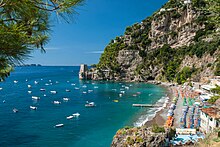
People have visited Italy for centuries, yet the first to visit the peninsula for tourism were aristocrats during the Grand Tour, which began in the 17th century, and flourished in the 18th and the 19th centuries.[329] This was a period in which European aristocrats, many of whom were British, visited parts of Europe, with Italy as a key destination.[329] For Italy, this was in order to study ancient architecture, local culture, and admire its natural beauty.[330]
Italy is the fifth most visited country, with a total of 52 million arrivals in 2016.[331] The contribution of travel and tourism to GDP was EUR163 billion in 2014 (10% of GDP) and 1,082,000 jobs directly related to tourism in 2014 (5% of employment).[332]
Tourist interest is mainly in culture, cuisine, history, architecture, art, religious sites and routes, wedding tourism, naturalistic beauties, nightlife, underwater sites, and spas.[333] Winter and summer tourism are present in locations in the Alps and the Apennines,[334] while seaside tourism is widespread among locations along the Mediterranean.[335] Italy is the leading cruise tourism destination in the Mediterranean.[336] Small, historical, and artistic Italian villages are promoted through the association I Borghi più belli d'Italia (lit. 'The Most Beautiful Villages of Italy').
The most visited regions of Italy, measured by nights spent in tourist accommodation, are Veneto, Tuscany, Lombardy, Emilia-Romagna, and Lazio.[337] Rome is the third most visited city in Europe, and 12th in the world, with 9.4 million arrivals in 2017.[338] In addition, Venice and Florence are among the world's top 100 destinations.
Italy has the highest number of UNESCO World Heritage Sites in the world: 58,[339] 53 are cultural and 5 natural.[340] There is a variety of hotels, ranging from 1 to 5 stars. According to ISTAT, in 2017, there were 32,988 hotels with 1,133,452 rooms and 2,239,446 beds.[341] For non-hotel facilities - campsites, tourist villages, accommodations for rent, agritourism, etc - in 2017 there were 171,915, with 2,798,352 beds.[341]
Culture

Italy is one of the birthplaces of Western culture and a cultural superpower.[342] Divided by politics for centuries until its unification in 1861, Italy's culture has been shaped by a multitude of regional customs and local centres of power and patronage.[343] Italy has had a central role in Western culture for millenia and is still recognised for its cultural traditions and artists. During the Middle Ages, courts competed to attract artists, and scholars, thus producing a legacy of monuments, paintings, music and literature. Italy has made a substantial contribution to the cultural and historical heritage of Europe.[344]
Architecture
Italy is known for its architectural achievements,[345] such as the construction of arches, domes, and similar structures by ancient Rome, the founding of the Renaissance architectural movement in the late 14th to 16th centuries, and being the homeland of Palladianism, a style that inspired movements such as Neoclassical architecture and influenced the designs of country houses of noblemen all over the world, notably in the UK and US during the late 17th to early 20th centuries.
Along with pre-historic architecture, the first people in Italy to begin a recognised sequence of designs were the Greeks and the Etruscans, progressing to classical Roman,[346] then the revival of the classical Roman era during the Renaissance, and evolving into the Baroque era. The Christian concept of the basilica, a style of church architecture that came to dominate in the Middle Ages, was invented in Rome. Basilicas were known for being long, rectangular buildings, built in an almost ancient Roman style often rich in mosaics and decorations. The early Christians were greatly inspired by the pagan Romans.[347]
Romanesque architecture, which flourished from approximately 800 to 1100 AD, was one of the most fruitful and creative periods in Italian architecture, when masterpieces, such as the Leaning Tower of Pisa in the Piazza dei Miracoli, and the Basilica of Sant'Ambrogio in Milan were built. It was known for its usage of Roman arches, stained glass windows, and curved columns. The main innovation of Italian Romanesque architecture was the vault, which had never been seen in Western architecture.[348]
Italian architecture significantly evolved during the Renaissance. Filippo Brunelleschi contributed to architectural design with his dome for the Cathedral of Florence, a feat of engineering not seen since antiquity.[349] A popular achievement of Italian Renaissance architecture was St. Peter's Basilica, designed by Donato Bramante in the early 16th century. Andrea Palladio influenced architects throughout Western Europe with the villas and palaces he designed in the 16th century.[350]
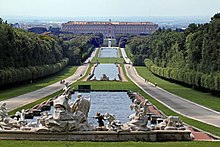
The Baroque period produced outstanding Italian architects in the 17th century. The most original work of late Baroque and Rococo architecture is the Palazzina di caccia di Stupinigi, dating to the 18th century.[351] Luigi Vanvitelli, in 1752, began the construction of the Royal Palace of Caserta.[352] In the late 18th and early 19th centuries Italy was influenced by the Neoclassical architectural movement. Villas, palaces, gardens, interiors, and art began again to be based on ancient Roman and Greek themes.[353]
During the Fascist period, the supposedly "Novecento movement" flourished, based on the rediscovery of imperial Rome. Marcello Piacentini, responsible for the urban transformations of cities and remembered for the disputed Via della Conciliazione in Rome, devised a form of simplified Neoclassicism.[354]
Visual art
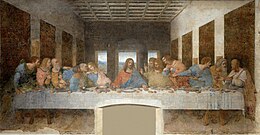
The history of Italian visual arts is significant to the history of Western painting. Roman art was influenced by Greece and can be taken as a descendant of ancient Greek painting. The only surviving Roman paintings are wall paintings. These can be grouped into four main "styles" or periods[355] and may contain the first examples of trompe-l'œil, pseudo-perspective, and pure landscape.[356]
The Italian Renaissance is considered to be the golden age of painting, spanning from the 14th through the mid-17th centuries and having significant influence outside of Italy. In Italy, artists such as Paolo Uccello, Masaccio, Filippo Lippi, Tintoretto, Sandro Botticelli, Leonardo da Vinci, Michelangelo Buonarroti, Raphael, and Titian took painting to a higher level through the use of perspective. The study of human anatomy and proportion led to a refinement of drawing and painting techniques. Michelangelo was active as a sculptor and his works include his David, Pietà, and Moses.
In the 15th and 16th centuries, the High Renaissance gave rise to a stylised art known as Mannerism. In place of the balanced compositions and rational approach to perspective that characterised art at the dawn of the 16th century, the Mannerists sought instability, artifice, and doubt. The unperturbed faces and gestures of Piero della Francesca and the calm Virgins of Raphael were replaced by the troubled expressions of Pontormo and the emotional intensity of El Greco.
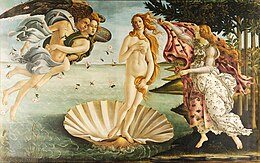
In the 17th century, among the greatest painters of Italian Baroque are Caravaggio, Artemisia Gentileschi, Carlo Saraceni, and Bartolomeo Manfredi. In the 18th century, Italian Rococo was mainly inspired by French Rococo, since France was the founding nation of that particular style. Italian Neoclassical sculpture focused, with Antonio Canova's nudes, on the idealist aspect of the movement.
In the 19th century, major Italian Romantic painters were Francesco Hayez, and Francesco Podesti. Impressionism was brought from France to Italy by the Macchiaioli; Realism by Gioacchino Toma and Giuseppe Pellizza da Volpedo. In the 20th century, with Futurism, Italy rose again as a seminal country for evolution in painting and sculpture. Futurism was succeeded by the metaphysical paintings of Giorgio de Chirico, who exerted a strong influence on the Surrealists and generations of artists.
Literature
Formal Latin literature began in 240 BC, when the first stage play was performed in Rome.[357] Latin literature was, and is, highly influential, with numerous writers, poets, philosophers, and historians, such as Pliny the Elder, Pliny the Younger, Virgil, Horace, Propertius, Ovid, and Livy. The Romans were famous for their oral tradition, poetry, drama, and epigrams.[358] In the early 13th century, Francis of Assisi was the first Italian poet, with his religious song Canticle of the Sun.[359]
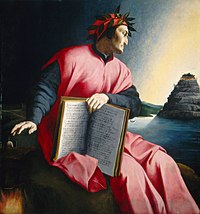
Another Italian voice originated in Sicily. At the court of Emperor Frederick II, during the 13th century, lyrics modelled on Provençal forms and themes were written in a refined version of the local vernacular. One of these poets was Giacomo da Lentini, inventor of the sonnet form, though the most famous early sonneteer was Petrarch.[361]
Guido Guinizelli is the founder of the Dolce Stil Novo, a school that added a philosophical dimension to traditional love poetry. This new understanding of love, expressed in a smooth, pure style, influenced the Florentine poet Dante Alighieri, who established the basis of modern Italian. Dante's work, the Divine Comedy, is among the finest works of literature;[360] furthermore, the poet invented the difficult terza rima. Petrarch and Giovanni Boccaccio, sought and imitated the works of antiquity and cultivated their own artistic personalities. Petrarch achieved fame through his collection of poems, Il Canzoniere. Equally influential was Boccaccio's The Decameron, one of the most popular collections of short stories ever written.[362]

Italian Renaissance authors' works include: Niccolò Machiavelli's The Prince, an essay on political science in which the "effectual truth" is taken to be more important than any abstract ideal. Giovanni Francesco Straparola and Giambattista Basile, who wrote The Facetious Nights of Straparola (1550–55) and the Pentamerone (1634), respectively, printed some of the first known versions of fairy tales in Europe.[363] In the early 17th century, masterpieces were created, such as Giambattista Marino's long mythological poem, L'Adone. The Baroque period produced the clear scientific prose of Galileo as well as Tommaso Campanella's The City of the Sun, a description of a perfect society ruled by a philosopher-priest. At the end of the 17th century, the Arcadians began a movement to restore simplicity and classical restraint to poetry.
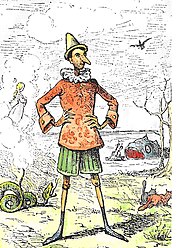
Italian writers embraced Romanticism in the early 19th century, it coincided with ideas of the Risorgimento, the patriotic movement that brought Italy political unity. Italy's rebirth was heralded by the poets Vittorio Alfieri, Ugo Foscolo, and Giacomo Leopardi. The works by Alessandro Manzoni, the leading Italian Romantic, are a symbol of Italian unification for their patriotic message and because of his efforts in the development of the modern, unified Italian language.[366]
In the late 19th century, a literary movement called Verismo, which extolled realism, played a major role in Italian literature. Emilio Salgari, a writer of action-adventure swashbucklers and a pioneer of science fiction, published his Sandokan series.[367] In 1883, Carlo Collodi published the The Adventures of Pinocchio, which became the most celebrated children's classic by an Italian author and one of the world's most translated non-religious books.[364] A movement called Futurism influenced Italian literature in the early 20th century. Filippo Tommaso Marinetti wrote Manifesto of Futurism and called for the use of language and metaphors that glorified the speed, dynamism, and violence of the machine age.[368]
Modern literary figures and Nobel laureates are Gabriele D'Annunzio active from 1889 to 1910, nationalist poet Giosuè Carducci 1906 Nobel laureate, realist writer Grazia Deledda laureate in 1926, modern theatre author Luigi Pirandello in 1936, short story writer Italo Calvino in 1960, poets Salvatore Quasimodo in 1959 and Eugenio Montale in 1975, Umberto Eco in 1980, and satirist and theatre author Dario Fo in 1997.[369]
Philosophy
Italian philosophy had an influence on Western philosophy, beginning with the Greeks and Romans, and Renaissance humanism, the Age of Enlightenment, and modern philosophy.[370] Philosophy was introduced to Italy by Pythagoras, the founder of the Italian school of philosophy in Crotone.[371] Italian philosophers of the Greek period include Xenophanes, Parmenides, Zeno, Empedocles, and Gorgias. Roman philosophers include Cicero, Lucretius, Seneca the Younger, Musonius Rufus, Plutarch, Epictetus, Marcus Aurelius, Augustine of Hippo, and Boethius.[370]

Italian Medieval philosophy was mainly Christian, and included theologians such as Thomas Aquinas, the foremost classical proponent of natural theology and the father of Thomism, who reintroduced Aristotelian philosophy to Christianity.[376] Notable Renaissance philosophers include: Giordano Bruno, one of the major scientific figures of the western world; Marsilio Ficino, an influential humanist philosophers; and Niccolò Machiavelli, one of the founders of modern political science. Machiavelli's most famous work is The Prince, whose contribution to political thought is the fundamental break between political idealism and realism.[377][378] University cities such as Padua, Bologna, and Naples remained centres of scholarship, with philosophers such as Giambattista Vico.[379] Cesare Beccaria was a significant Enlightenment figure and one of the fathers of classical criminal theory as well as modern penology.[374] Beccaria is known for his On Crimes and Punishments (1764), a treatise that served as one of the earliest prominent condemnations of torture and the death penalty.[378]
Italy had a renowned philosophical movement in the 1800s, with Idealism, Sensism, and Empiricism.[379] Criticism of the Sensist movement came from philosophers, who affirmed that a priori relationships were synthetic.[379] During the late 19th and 20th centuries, there were other movements that gained popularity, such as Ontologism,[380] anarchism, communism, socialism, futurism, fascism, and Christian democracy. Anarcho-communism first fully formed into its modern strain within the Italian section of the First International.[381] Antonio Gramsci remains a relevant philosopher within Marxist and communist theory, credited with creating the theory of cultural hegemony. Italian philosophers were influential in the development of the non-Marxist liberal socialism philosophy. In the 1960s, Italian left-wing activists adopted the anti-authoritarian pro-working class leftist theories that would become known as autonomism and operaismo.[382]
Early Italian feminists include Sibilla Aleramo, Alaide Gualberta Beccari, and Anna Maria Mozzoni, though proto-feminist philosophies had previously been touched upon by Italian writers. Italian physician and educator Maria Montessori is credited with the creation of the philosophy of education that bears her name.[375] Giuseppe Peano was one of the founders of analytic philosophy and the contemporary philosophy of mathematics. Recent analytic philosophers include Carlo Penco, Gloria Origgi, Pieranna Garavaso, and Luciano Floridi.[370]
Theatre

Italian theatre came about in the Middle Ages, with its antecedents dating back to ancient Greek colonies in southern Italy,[384] as well as the theatre of the Italic peoples[385] and the theatre of ancient Rome. There were two main lines along which theatre developed in the Middle Ages. The first, consisting of the dramatization of Catholic liturgies, and the second, formed by pagan forms of spectacle such as the staging for city festivals, the court preparations of the jesters, and the songs of the troubadours.[386] Renaissance theatre marked the beginning of modern theatre due to the rediscovery of the classics. Ancient theatrical texts, recovered and translated, were staged at royal courts, and moved to public theatres. The idea of theatre came close to that of today: a performance in a designated place in which the public participates. In the late 15th century, two cities were important for the rediscovery and renewal of theatrical art: Ferrara and Rome. The first, vital centre of art in the second half of the fifteenth century, saw the staging of Latin works by Plautus, translated into Italian.[387]

During the 16th century, into the 18th century, commedia dell'arte was a form of improvisational theatre, and is still performed. Travelling troupes of players set up an outdoor stage and provided amusement in the form of juggling, acrobatics, and, more typically, humorous plays. Plays did not originate from written drama but from scenarios called lazzi, loose frameworks around which actors would improvise. The characters of the commedia usually represent fixed social types and stock characters, each of which has a distinct costume.[388] The first recorded commedia dell'arte performances came from Rome as early as 1551.[389]
In commedia dell'arte, female roles were played by women, which was documented as early as the 1560s, making them the first known professional actresses in Europe since antiquity. Lucrezia Di Siena, whose name is on a contract from 1564, has been referred to as the first Italian actress known by name, with Vincenza Armani and Barbara Flaminia as the first prima donnas.[390]
Ballet originated in Italy. It began during the Renaissance as an outgrowth of court pageantry,[391] where aristocratic weddings were lavish celebrations. Court musicians and dancers collaborated to provide elaborate entertainment.[392] At first, ballets were woven into the midst of an opera to allow the audience relief from dramatic intensity. By the mid-seventeenth century, ballets in their entirety were performed between acts of an opera. Ballets became part of theatrical life.[393]
Music

From folk music to classical, music is an intrinsic part of Italian culture. Instruments associated with classical music, including the piano and violin, were invented in Italy,[394] and many prevailing forms, such as the symphony, concerto, and sonata, can trace their roots back to innovations in 16th- and 17th-century Italian music.
Italy's most famous composers include the Renaissance composers Palestrina, Monteverdi, and Gesualdo; the Baroque composers Scarlatti, and Vivaldi; the Classical composers Paisiello, Paganini, and Rossini; and the Romantic composers Verdi and Puccini. While classical music still has a strong hold in Italy, as evidenced by the fame of its opera houses, and performers such as the pianist Maurizio Pollini and tenor Luciano Pavarotti, Italians have been no less appreciative of their thriving contemporary music scene.
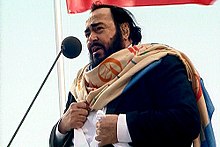
Italy is known for being the birthplace of opera.[396] Italian opera was believed to have been founded in the early 17th century.[396] Works and pieces composed by native Italian composers of the 19th and early 20th centuries, such as Rossini, Bellini, Donizetti, Verdi, and Puccini, are among the most famous operas and performed across the world. La Scala opera house in Milan is renowned as one of the best in the world.
Introduced in the early 1920s, jazz gained a particularly strong foothold in Italy, and remained popular despite the xenophobic policies of the Fascist regime. The most notable centres of jazz include Milan, Rome, and Sicily. Italy was represented in the progressive rock and pop movements of the 1970s, with bands such as PFM, Banco del Mutuo Soccorso, Le Orme, Goblin, and Pooh.[397] The same period saw diversification in the cinema of Italy, and Cinecittà films included complex scores by composers including Ennio Morricone, Armando Trovaioli, Piero Piccioni, and Piero Umiliani. In the early 1980s, the first star to emerge from the Italian hip hop scene was singer Jovanotti.[398] Italian metal bands include Rhapsody of Fire, Lacuna Coil, Elvenking, Forgotten Tomb, and Fleshgod Apocalypse.
Italy contributed to the development of disco and electronic music, with Italo disco, known for its futuristic sound and prominent use of synthesisers and drum machines, being one of the earliest electronic dance genres, as well as European forms of disco, aside from Euro disco.[399]
Producers such as Giorgio Moroder, who won three Academy Awards and four Golden Globes, were influential in the development of electronic dance music.[400] Italian pop is represented annually with the Sanremo Music Festival, which served as inspiration for the Eurovision song contest.[401] Singers such as Mina, Andrea Bocelli, Grammy winner Laura Pausini, Zucchero, Eros Ramazzotti, Elisa, Tiziano Ferro, and Mahmood have received international acclaim.
Gigliola Cinquetti, Toto Cutugno, and Måneskin won the Eurovision Song Contest, in 1964, 1990, and 2021 respectively.
Cinema

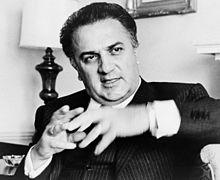
Italian cinema began a few months after the Lumière brothers introduced motion picture exhibitions.[404] The first Italian director is considered to be Vittorio Calcina, who filmed Pope Leo XIII in 1896.[405] In the 1910s, the film industry developed rapidly.[406] In 1912, 569 films were produced in Turin, and 420 in Rome.[407] Cabiria, from 1914, is the most famous Italian silent film.[406][408] It was the first film to be shown at the White House.[409] The oldest European avant-garde cinema movement, Italian futurism, took place in the late 1910s.[410]
After decline in the 1920s, the film industry was revitalized in the 1930s with the arrival of sound film. A popular Italian genre, the Telefoni Bianchi, consisted of comedies with glamorous backgrounds.[411] Calligrafismo was a sharp contrast to Telefoni Bianchi-American style comedies and is rather artistic, highly formalistic, expressive in complexity, and deals mainly with contemporary literary material.[412] Cinema was used by Mussolini, who founded Rome's renowned Cinecittà studio, for the production of Fascist propaganda until World War II.[413]
After the war, Italian film was widely recognised and exported until an artistic decline occurred in the 1980s.[414] Notable Italian film directors include Vittorio De Sica, Federico Fellini, Sergio Leone, Pier Paolo Pasolini, Luchino Visconti, Michelangelo Antonioni and Roberto Rossellini, recognised among the greatest of all time.[415] Movies include treasures such as Bicycle Thieves, La Dolce Vita, 8½, The Good, the Bad and the Ugly, and Once Upon a Time in the West. The mid-1940s to the early 1950s was the heyday of neorealist films, reflecting the poor condition of post-war Italy.[416]
As the country grew wealthier in the 1950s, a form of neorealism known as pink neorealism succeeded, and the commedia all'italiana genre and other film genres, such as sword-and-sandal and spaghetti Westerns, were popular in the 1960s and 1970s.[417] Actresses such as Sophia Loren achieved international stardom. Erotic Italian thrillers, or gialli, produced by directors such as Mario Bava and Dario Argento in the 1970s, influenced the horror genre.[418] Recently, the Italian scene has received only occasional attention, with movies such as Cinema Paradiso, Life Is Beautiful and Il Postino: The Postman.[419]
Cinecittà studio is the largest film and television production facility in Europe,[402] where many international box office hits were filmed. In the 1950s, the number of international productions made there led to Rome's being dubbed "Hollywood on the Tiber". More than 3,000 productions have been made on its lot, of which 90 received an Academy Award nomination, 47 of these having won.[420]
Italy is the most awarded country at the Academy Awards for Best Foreign Language Film, with 14 wins and 3 Special Awards.[421] As of 2016[update], Italian films have won 12 Palmes d'Or,[422] 11 Golden Lions,[423] and 7 Golden Bears.[424]
Sport

The most popular sport in Italy is football.[425] Italy's national football team is one of the world's most successful teams, with four FIFA World Cup victories (1934, 1938, 1982, and 2006) and two UEFA Euro victories (1968 and 2021).[426] Italian clubs have won 48 major European trophies, making Italy the second most successful country in European football. Italy's top-flight club football league is named Serie A and is followed by millions of fans around the world.[427]
Other popular team sports in Italy include basketball, volleyball, and rugby.[428] Italy's male and female national volleyball teams are often featured among the world's best. The Italian national basketball team's best results were gold at Eurobasket 1983 and EuroBasket 1999, as well as silver at the Olympics in 2004. Lega Basket Serie A is one of the most competitive in Europe.[429] The Italy national rugby union team competes in the Six Nations Championship, and regularly at the Rugby World Cup. The men's volleyball team won three consecutive World Championships (in 1990, 1994 and 1998).

Italy has a long and successful tradition in individual sports. Bicycle racing is popular;[431] Italians have won the UCI World Championships more than any other country, except Belgium. The Giro d'Italia is a cycling race held every May and one of the three Grand Tours. Alpine skiing is a widespread sport, and the country is a popular skiing destination.[432] Italian skiers achieve good results in Winter Olympic Games and the Alpine Ski World Cup. Tennis has a significant following in Italy, ranking as the fourth most practised sport.[433] The Rome Masters, founded in 1930, is one of the most prestigious tennis tournaments.[434] Italian professional tennis players won the Davis Cup in 1976 and the Fed Cup in 2006, 2009, 2010, and 2013.

Motorsports are popular in Italy.[428] Italy has won, by far, the most MotoGP World Championships. Italian Scuderia Ferrari is the oldest surviving team in Grand Prix racing,[435] having competed since 1948, and the most successful Formula One team with 232 wins. The Italian Grand Prix of Formula One is the fifth oldest surviving Grand Prix, being held since 1921.[436] Every Formula 1 Grand Prix (except 1980) has been held at Autodromo Nazionale Monza.[437] Other successful Italian car manufacturers in motorsports are Alfa Romeo, Lancia, Maserati, and Fiat.[438]
Italy has been successful in the Olympics, taking part from the first Olympiad and in 47 Games out of 48 (not 1904).[439] Italian sportsmen have won 522 medals at the Summer Olympic Games, and 106 at the Winter Olympics, for a combined total of 628 medals, with 235 golds, the fifth most successful nation in history for total medals. The country hosted two Winter Olympics (in 1956 and 2006) and will host a third in 2026); and one Summer games (in 1960).
Fashion and design

Italian fashion has a long tradition. Top Global Fashion Capital Rankings (2013) by Global Language Monitor, ranked Rome sixth and Milan twelfth.[440] Major Italian fashion labels—such as Gucci, Armani, Prada, Versace, Valentino, Dolce & Gabbana—are among the finest fashion houses in the world. Jewellers such as Bvlgari, Damiani, and Buccellati were founded in Italy. The fashion magazine Vogue Italia is one of the most prestigious fashion magazines in the world.[441]
Italy is prominent in the field of design: notably interior, architectural, industrial, and urban designs. The country has produced well-known furniture designers, and Italian phrases such as Bel Disegno and Linea Italiana have entered the vocabulary of furniture design.[442] Examples of classic pieces of Italian white goods and pieces of furniture include Zanussi's washing machines and refrigerators,[443] and the "New Tone" sofas by Atrium.[443] Milan and Turin are the nation's leaders in architectural and industrial design. The city of Milan hosts Fiera Milano, Europe's largest design fair.[444] Milan hosts major design- and architecture-related events and venues, such as the Fuori Salone and the Milan Furniture Fair, and has been home to the designers Bruno Munari, Lucio Fontana, Enrico Castellani, and Piero Manzoni.[445]
Cuisine


Italian cuisine has developed through social and political changes, with roots as far back as the 4th century BC. The cuisine is heavily influenced by Etruscan, ancient Greek, ancient Roman, Byzantine, Arabic, and Jewish cuisines.[446] Significant changes occurred with the discovery of the New World, with items such as potatoes, tomatoes, and maize becoming main ingredients from the 18th century.[447] Italian cuisine is noted for its regional diversity,[448] abundance of difference in taste, and as one of the most popular in the world,[449] wielding strong influence abroad.[450]
The Mediterranean diet forms the basis of Italian cuisine, which is rich in pasta, fish, fruits, and vegetables and characterised by its simplicity and variety, with many dishes having only four to eight ingredients.[451] Italian cooks rely chiefly on the quality of the ingredients rather than elaborate preparation.[452] Dishes and recipes are often derivatives from local and familial tradition rather than created by chefs; so, many recipes are ideally suited for home cooking, this is the main reason behind the popularity of Italian cuisine from America[453] to Asia.[454]
Italian cuisine relies heavily on traditional products; the country has traditional specialties protected under EU law.[455] Cheese, cold cuts, and wine are central to Italian cuisine, with regional declinations and Protected Designation of Origin or Protected Geographical Indication labels, along with pizza and coffee forming part of gastronomic culture.[456] Desserts have a long tradition of merging local flavours, such as citrus fruits, pistachio, and almonds, with sweet cheeses such as mascarpone and ricotta or exotic tastes such as cocoa, vanilla, and cinnamon. Gelato,[457] tiramisu,[458] and cassata are among the most famous examples of Italian desserts, cakes, and patisserie.
The Italian meal structure is typical of the Mediterranean region and differs from North, Central, and East European meal structures, though it still often consists of breakfast (colazione), lunch (pranzo), and dinner (cena).[459] However, much less emphasis is placed on breakfast, which is often skipped or involves lighter portions than are seen in non-Mediterranean Western countries.[460] Late-morning and mid-afternoon snacks, called merenda (pl.: merende), are often included in this structure.[461]
The marketing phenomenon consisting of words and images, colour combinations (Italian tricolour) and geographical references for brands that are evocative of Italy, to promote and market agri-food products, unrelated to Italian cuisine, is known as Italian Sounding.[462]
Public holidays, festivals and folklore

Public holidays celebrated in Italy include religious, national, and regional observances. Italy's National Day, the Festa della Repubblica (Republic Day),[463] is celebrated on 2 June , with the main celebration taking place in Rome, and commemorates the birth of the Italian Republic in 1946.[464] The ceremony includes deposition of a laurel wreath as a tribute to the Italian Unknown Soldier by the President and a military parade.
The Saint Lucy's Day, which takes place on 13 December, is popular among children in some Italian regions, where she plays a role similar to Santa Claus.[465] The Epiphany is associated with the folklore figure of the Befana, a broomstick-riding old woman who, on the night of 5 January, brings good children gifts and sweets, and bad ones charcoal or bags of ashes.[466] The Assumption of Mary coincides with Ferragosto on 15 August, the summer vacation period which may be a long weekend or most of the month.[467]
The Italian national patronal day, on 4 October, celebrates Saints Francis and Catherine. Each city or town also celebrates a public holiday on the festival of the local patron saint.[464] For example: Rome on 29 June (Saints Peter and Paul), Milan on 7 December (Saint Ambrose) and Florence on 24 June (Saint John the Baptist).
There are many festivals and festivities, they include: the Palio di Siena horse race, Holy Week rites, Saracen Joust of Arezzo and the Calcio Fiorentino. In 2013, UNESCO included among the intangible cultural heritage some Italian festivals and pasos, such as the Varia di Palmi, the Macchina di Santa Rosa in Viterbo, the Festa dei Gigli in Nola, and faradda di li candareri in Sassari.[468]
Other festivals include the carnivals in Venice, Viareggio, Satriano di Lucania, Mamoiada, and Ivrea, mostly known for its Battle of the Oranges. The Venice International Film Festival, awarding the Golden Lion and held since 1932, is the oldest film festival in the world and one of the "Big Three" European film festivals, alongside the Cannes Film Festival and the Berlin International Film Festival.[469]
See also
Notes
- ^ Italian: Italia, Italian: [iˈtaːlja]
- ^ Italian: Repubblica Italiana, Italian: [reˈpubblika itaˈljaːna]
- ^ Italy is often grouped in Western Europe.[15]
- ^ Though the modern state of Italy had yet to be established, the Latin equivalent of the term Italian had been in use for natives of the region since antiquity. See Pliny the Elder, Letters 9.23.
- ^ The Guardia di Finanza operates a large fleet of ships, aircraft and helicopters, enabling it to patrol Italy's waters and to eventually participate in warfare scenarios.
- ^ The Holy See's sovereignty has been recognized explicitly in many international agreements and is particularly emphasized in article 2 of the Lateran Treaty of 11 February 1929, in which "Italy recognizes the sovereignty of the Holy See in international matters as an inherent attribute in conformity with its traditions and the requirements of its mission to the world" (Lateran Treaty, English translation).
References
- ^ a b "Indicatori demografici, anno 2020" (PDF). Archived (PDF) from the original on 3 May 2021. Retrieved 3 May 2021.
- ^ "Special Eurobarometer 516". European Union: European Commission. September 2021. Archived from the original on 29 June 2023. Retrieved 24 September 2021 – via European Data Portal (see Volume C: Country/socio-demographics: IT: Question D90.2.).
- ^ a b "Italy". Central Intelligence Agency. 23 August 2023. Archived from the original on 1 July 2021. Retrieved 28 August 2023.
- ^ "Italy country profile". BBC News. 12 November 2023. Archived from the original on 18 December 2023. Retrieved 12 November 2023.
- ^ "Surface water and surface water change". Organisation for Economic Co-operation and Development (OECD). Archived from the original on 24 March 2021. Retrieved 11 October 2020.
- ^ "ISTAT – Demography, Statistics, Demographic Balance, Resident Population". demo.istat.it. Archived from the original on 15 August 2022. Retrieved 22 September 2022.
- ^ a b c d "World Economic Outlook Database, April 2024 Edition. (Italy)". International Monetary Fund. 16 April 2024. Retrieved 16 April 2024.
- ^ "Gini coefficient of equivalised disposable income – EU-SILC survey". European Commission. Archived from the original on 9 October 2020. Retrieved 21 June 2022.
- ^ "Human Development Report 2023/24" (PDF). United Nations Development Programme. 13 March 2024. p. 288. Archived (PDF) from the original on 13 March 2024. Retrieved 13 March 2024.
- ^ Year-month-day also sometimes used, though rarely, mainly used for computing contexts. See Date and time notation in Italy.
- ^ "Legge Regionale 15 ottobre 1997, n. 26". Regione autonoma della Sardegna – Regione Autònoma de Sardigna. Archived from the original on 26 February 2021. Retrieved 31 May 2018.; "Regione Autonoma Friuli-Venezia Giulia – Comunità linguistiche regionali". regione.fvg.it. Archived from the original on 4 September 2015. Retrieved 2 November 2020.
- ^ "Comune di Campione d'Italia". Comune.campione-d-italia.co.it. 14 July 2010. Archived from the original on 30 April 2011. Retrieved 30 October 2010.
- ^ "Southern Europe, a peninsula extending into the central Mediterranean Sea, northeast of Tunisia". The World Factbook. Central Intelligence Agency. Archived from the original on 1 July 2021. Retrieved 17 August 2021.
- ^ a b "UNITED NATIONS DGACM". United Nations. Archived from the original on 21 August 2017. Retrieved 24 September 2019.
- ^ Academic works describing Italy as a Western European country:
- Hancock, M. Donald; Conradt, David P.; Peters, B. Guy; Safran, William; Zariski, Raphael (11 November 1998). Politics in Western Europe: an introduction to the politics of the United Kingdom, France, Germany, Italy, Sweden, and the European Union (2nd ed.). Chatham House Publishers. ISBN 978-1-5664-3039-5.
list of Western European countries Italy.
- Ugo, Ascoli; Emmanuele, Pavolini (2016). The Italian welfare state in a European perspective: A comparative analysis. Policy Press. ISBN 978-1-4473-3444-6.
- Zloch-Christy, Iliana (1991). East-West Financial Relations: Current Problems and Future Prospects. Cambridge University Press. ISBN 978-0-5213-9530-4. Retrieved 29 September 2019.
list of Western European countries Italy.
- Clout, Hugh D. (1989). Western Europe: Geographical Perspectives. Longman Scientific & Technical. ISBN 978-0-5820-1772-6. Retrieved 29 September 2019.
- Furlong, Paul (2003). Modern Italy: Representation and Reform. Routledge. ISBN 978-1-1349-7983-7. Retrieved 29 September 2019.
- Hanf, Kenneth; Jansen, Alf-Inge (2014). Governance and Environment in Western Europe: Politics, Policy and Administration. Routledge. ISBN 978-1-3178-7917-6. Retrieved 29 September 2019.
- Hancock, M. Donald; Conradt, David P.; Peters, B. Guy; Safran, William; Zariski, Raphael (11 November 1998). Politics in Western Europe: an introduction to the politics of the United Kingdom, France, Germany, Italy, Sweden, and the European Union (2nd ed.). Chatham House Publishers. ISBN 978-1-5664-3039-5.
- ^ a b "Italia", Dizionario enciclopedico italiano (in Italian), vol. VI, Treccani, 1970, p. 413
- ^ "Italy Population 2022 (Demographics, Maps, Graphs)". worldpopulationreview.com. Archived from the original on 21 February 2022. Retrieved 21 February 2022.
- ^ Carl Waldman; Catherine Mason (2006). Encyclopedia of European Peoples. Infobase Publishing. p. 586. ISBN 978-1-4381-2918-1. Archived from the original on 11 March 2023. Retrieved 23 February 2013.; Mommsen, Theodor (1855). History of Rome, Book II: From the Abolition of the Monarchy in Rome to the Union of Italy. Leipzig: Reimer & Hirsel.; Lazenby, John Francis (4 February 1998). Hannibal's War: A Military History of the Second Punic War. University of Oklahoma Press. p. 29. ISBN 978-0-8061-3004-0 – via Internet Archive.
Italy homeland of the Romans.
- ^ a b Sée, Henri. "Modern Capitalism Its Origin and Evolution" (PDF). University of Rennes. Batoche Books. Archived from the original (PDF) on 7 October 2013. Retrieved 29 August 2013.
- ^ "Italian Trade Cities | Western Civilization". courses.lumenlearning.com. Archived from the original on 2 November 2021. Retrieved 21 September 2022.
- ^ "Gli antichi Stati italiani" (PDF) (in Italian). Archived (PDF) from the original on 26 July 2023. Retrieved 26 July 2023.; Accetturo, Antonio; Mocetti, Sauro (2019). "Historical Origins and Developments of Italian Cities". Italian Economic Journal. 5 (2): 205–222. doi:10.1007/s40797-019-00097-w.



